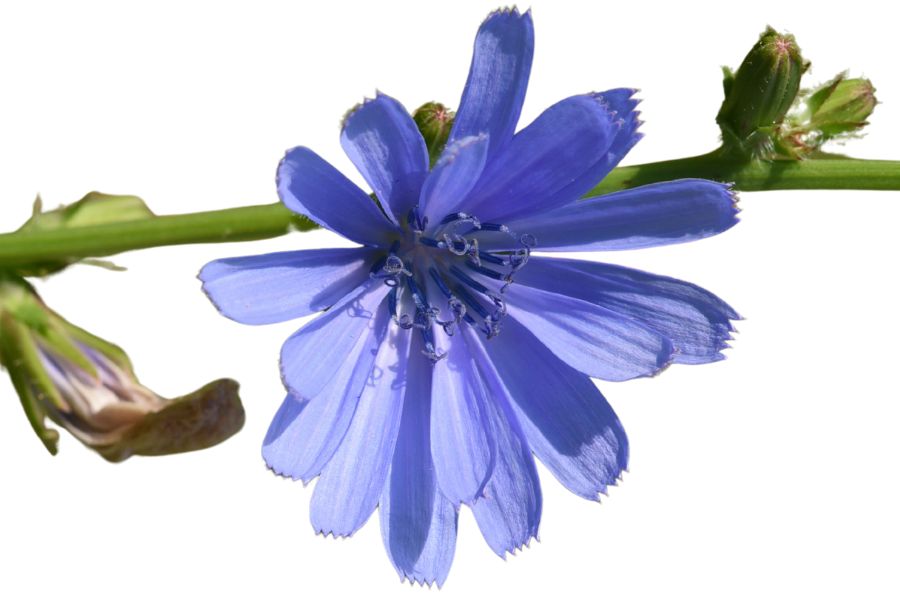Across Illinois, edible plants are growing in places most people don’t give a second glance. Whether you’re in a prairie clearing or near a shaded stream, a trained eye can spot ingredients waiting to be harvested.
Chicory has edible leaves and roots, the latter often roasted as a coffee substitute. Stinging nettle must be handled carefully but cooks down into a rich, nutritious green.
Many plants with multiple edible parts are easy to prepare in simple meals, like plantain leaves or curly dock. A few, like black walnuts, require more effort but reward you with rich flavor and high food value.
This state has an impressive variety of edible plant life once you start paying attention. Knowing what to look for and how to identify them can turn an ordinary hike into a rewarding haul of wild foods.
What We Cover In This Article:
- The Edible Plants Found in the State
- Toxic Plants That Look Like Edible Plants
- How to Get the Best Results Foraging
- Where to Find Forageables in the State
- Peak Foraging Seasons
- The extensive local experience and understanding of our team
- Input from multiple local foragers and foraging groups
- The accessibility of the various locations
- Safety and potential hazards when collecting
- Private and public locations
- A desire to include locations for both experienced foragers and those who are just starting out
Using these weights we think we’ve put together the best list out there for just about any forager to be successful!
A Quick Reminder
Before we get into the specifics about where and how to find these plants and mushrooms, we want to be clear that before ingesting any wild plant or mushroom, it should be identified with 100% certainty as edible by someone qualified and experienced in mushroom and plant identification, such as a professional mycologist or an expert forager. Misidentification can lead to serious illness or death.
All plants and mushrooms have the potential to cause severe adverse reactions in certain individuals, even death. If you are consuming wild foragables, it is crucial to cook them thoroughly and properly and only eat a small portion to test for personal tolerance. Some people may have allergies or sensitivities to specific mushrooms and plants, even if they are considered safe for others.
The information provided in this article is for general informational and educational purposes only. Foraging involves inherent risks.
The Edible Plants Found in the State
Wild plants found across the state can add fresh, seasonal ingredients to your meals:
Dandelion (Taraxacum officinale)
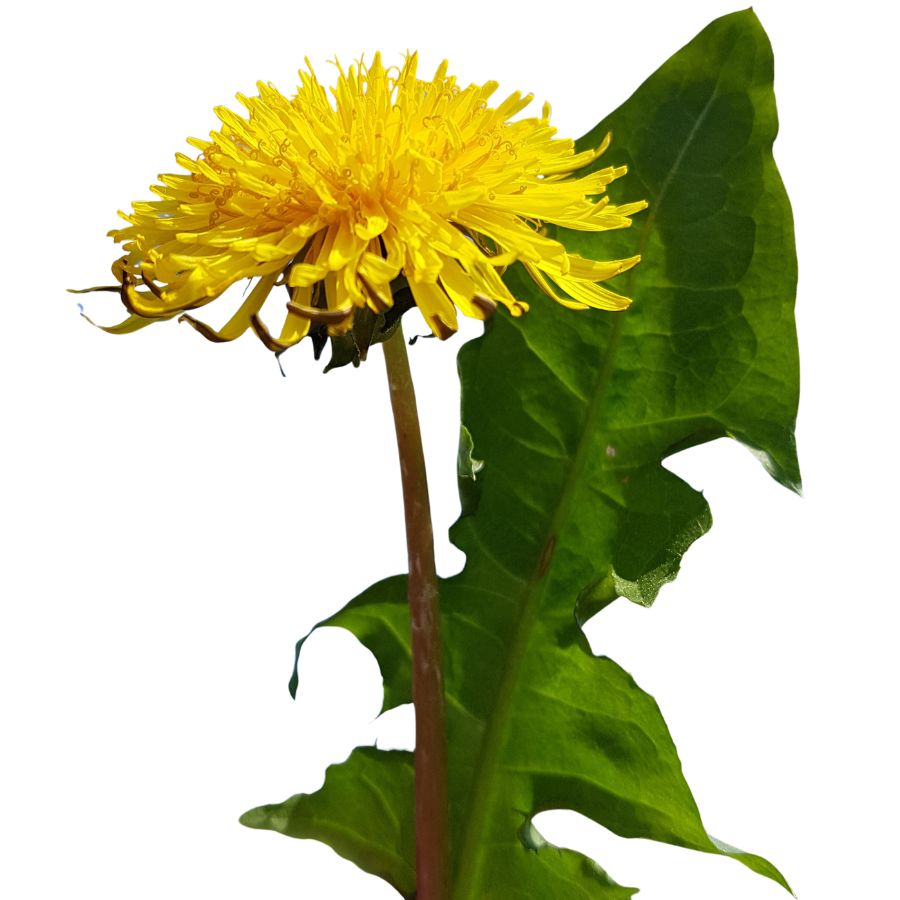
Bright yellow flowers and jagged, deeply toothed leaves make dandelions easy to spot in open fields, lawns, and roadsides. You might also hear them called lion’s tooth, blowball, or puffball once the flowers turn into round, white seed heads.
Every part of the dandelion is edible, but you will want to avoid harvesting from places treated with pesticides or roadside areas with heavy car traffic. Besides being a food source, dandelions have been used traditionally for simple herbal remedies and natural dye projects.
Young dandelion leaves have a slightly bitter, peppery flavor that works well in salads or sautés, and the flowers can be fried into fritters or brewed into tea. Some people even roast the roots to make a coffee substitute with a rich, earthy taste.
One thing to watch out for is cat’s ear, a common lookalike with hairy leaves and branching flower stems instead of a single, hollow one. To make sure you have a true dandelion, check for a smooth, hairless stem that oozes a milky sap when broken.
Pawpaw (Asimina triloba)
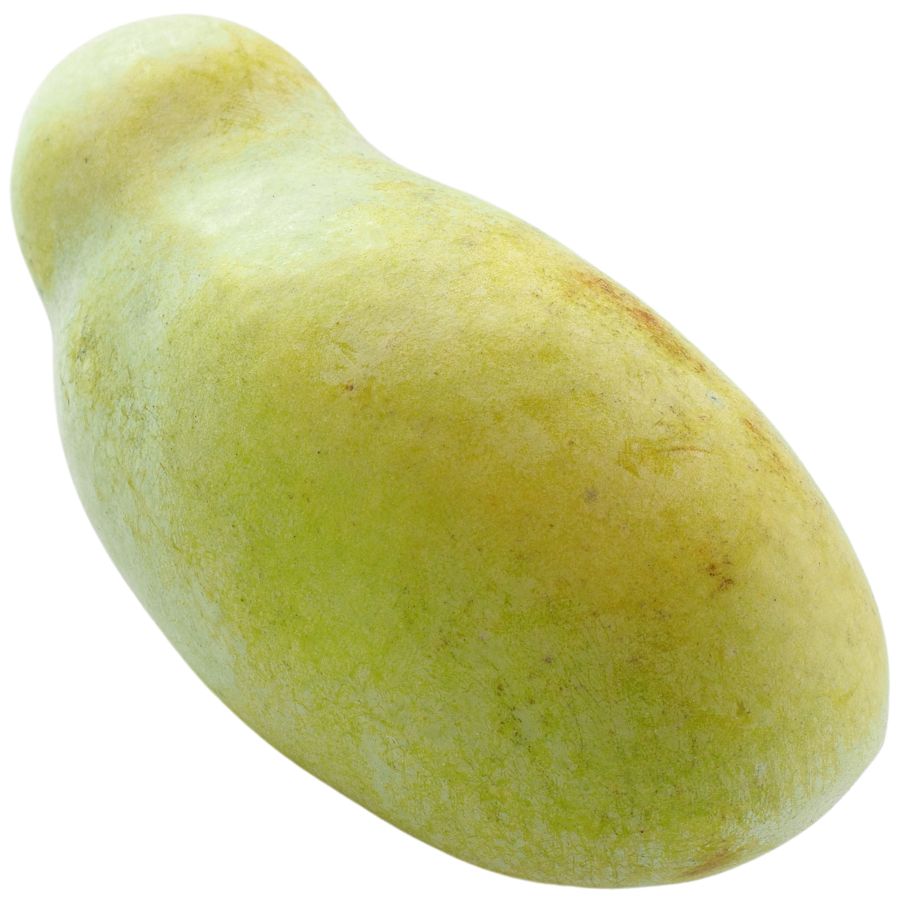
The pawpaw grows fruits that are green and shaped a little like small mangoes. Inside, the soft yellow flesh tastes like a blend of banana, mango, and melon, with a custard-like texture that melts in your mouth.
If you are comparing it to similar plants, keep in mind that young pawpaw trees can look a little like young magnolias because of their large leaves. True pawpaws grow fruits with large brown seeds tucked inside, while magnolias do not produce anything that looks or tastes similar.
You can eat the flesh straight out of the skin with a spoon, or mash it into puddings, smoothies, and even homemade ice cream. Some people also like to freeze it into cubes for later, although it does tend to brown quickly once exposed to air.
Stick to eating the soft inner flesh. Make sure not to ingest the skin and seeds of the fruit because they contain compounds that can upset your stomach.
This fruit is that it was a favorite snack of Native Americans and early explorers long before it started showing up in backyard gardens.
Common Blue Violet (Viola sororia)
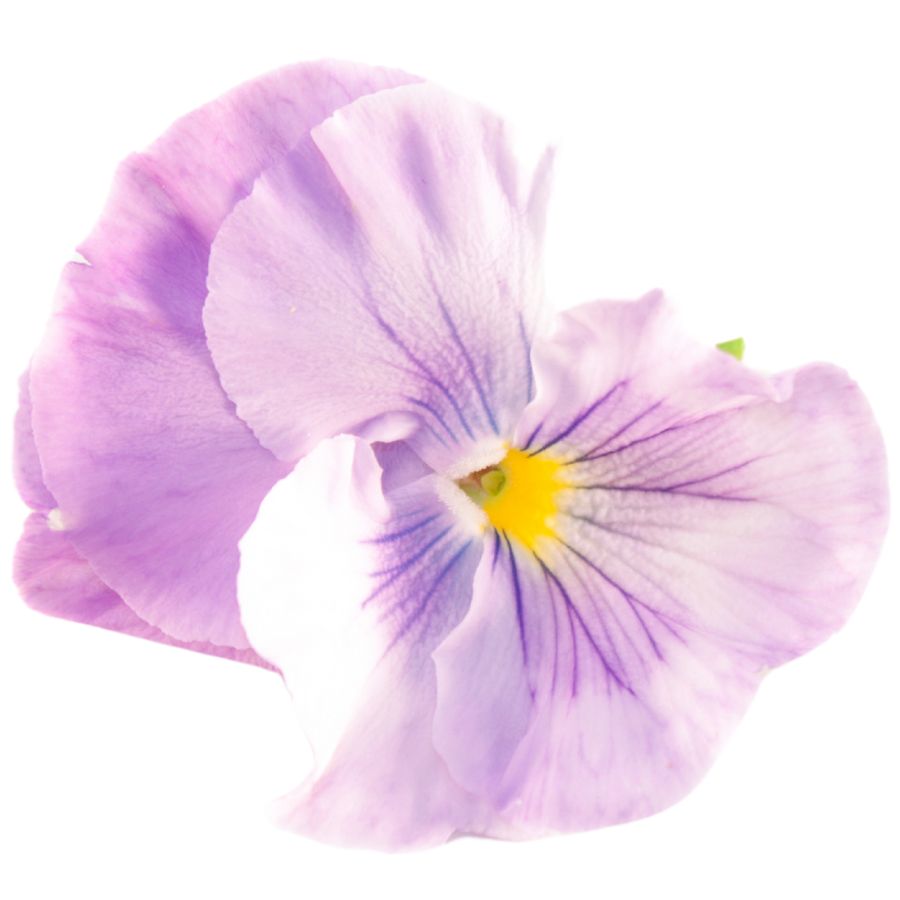
Common blue violet, also called wood violet and meadow violet, grows close to the ground with heart-shaped leaves and purple flowers. The blossoms have five petals, with the lower petal often streaked in darker lines that act like nectar guides for pollinators.
You can eat both the flowers and the young leaves, but skip the older leaves since they tend to get tough and stringy. The blooms taste mild and a little sweet, while the leaves are more grassy and bland.
People often use the flowers to decorate cakes, candy them for treats, or toss them into salads for a pop of color. The leaves can be thrown into soups or smoothies, but it is better to chop them fine because they have a slightly mucilaginous texture.
One plant that sometimes gets confused with common blue violet is lesser celandine, which has shiny, darker leaves and starry yellow flowers instead of purple ones. Always double-check before gathering because eating lesser celandine raw can make you sick.
Groundnut (Apios americana)

Groundnut is also called potato bean or Indian potato, and it grows as a climbing vine with clusters of pinkish-purple flowers. The part most people go for is the underground tuber, which looks a bit like a small, knobby chain of beads.
The flavor is richer than a regular potato, with a nutty, earthy taste and a dense, almost chestnut-like texture when cooked. It holds up well in soups and stews, or you can boil and mash it like a root vegetable.
Some people slice it thin and roast it until crisp, while others slow-cook it to bring out a sweeter taste. The vine also produces beans, but the root is what’s usually eaten.
There are a few vines that resemble groundnut, but many of those don’t have the same distinctive flower clusters or tend to lack the beadlike roots. Always make sure you’re digging up the right plant before cooking it.
Cattail (Typha spp.)
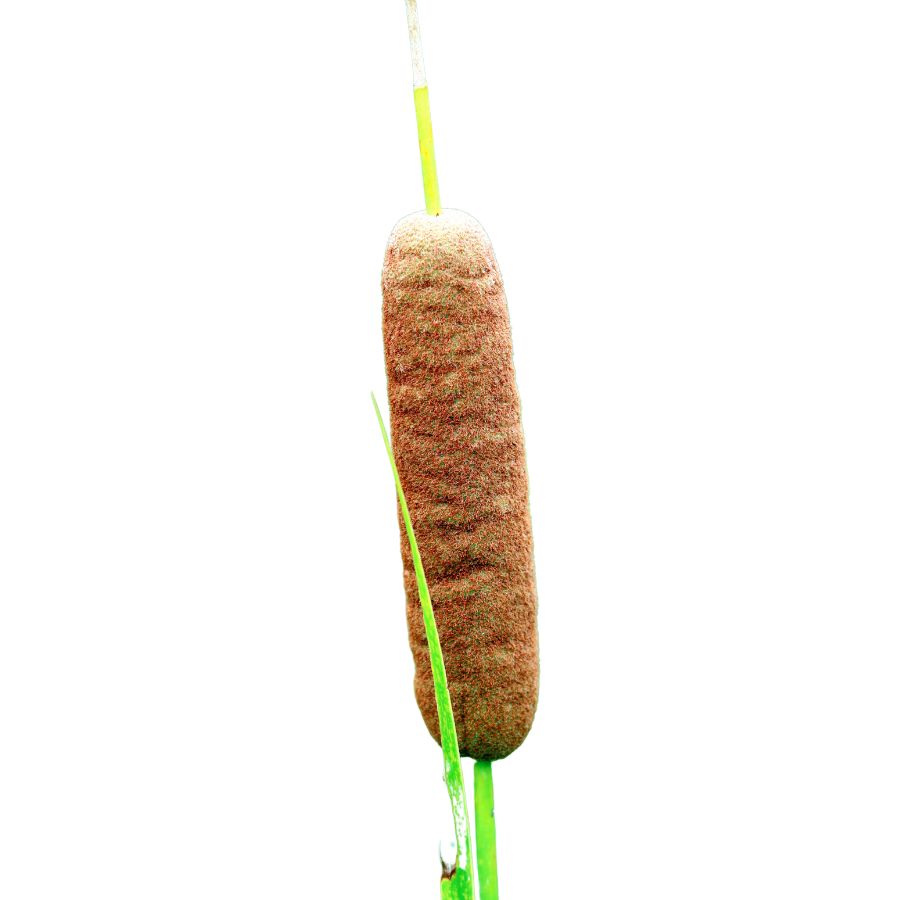
Cattails, often called bulrushes or corn dog grass, are easy to spot with their tall green stalks and brown, sausage-shaped flower heads. They grow thickly along the edges of ponds, lakes, and marshes, forming dense stands that are hard to miss.
Almost every part of the cattail is edible, including the young shoots, flower heads, and starchy rhizomes. You can eat the tender shoots raw, boil the flower heads like corn on the cob, or grind the rhizomes into flour for baking.
Besides food, cattails have long been used for making mats, baskets, and even insulation by weaving the dried leaves and using the fluffy seeds. Their combination of usefulness and abundance has made them an important survival plant for many cultures.
One thing you need to watch for is young cattail shoots being confused with similar-looking plants like iris, which are toxic. A real cattail shoot will have a mild cucumber-like smell when you snap it open, while iris plants smell bitter or unpleasant.
Wild Leek / Ramp (Allium tricoccum)
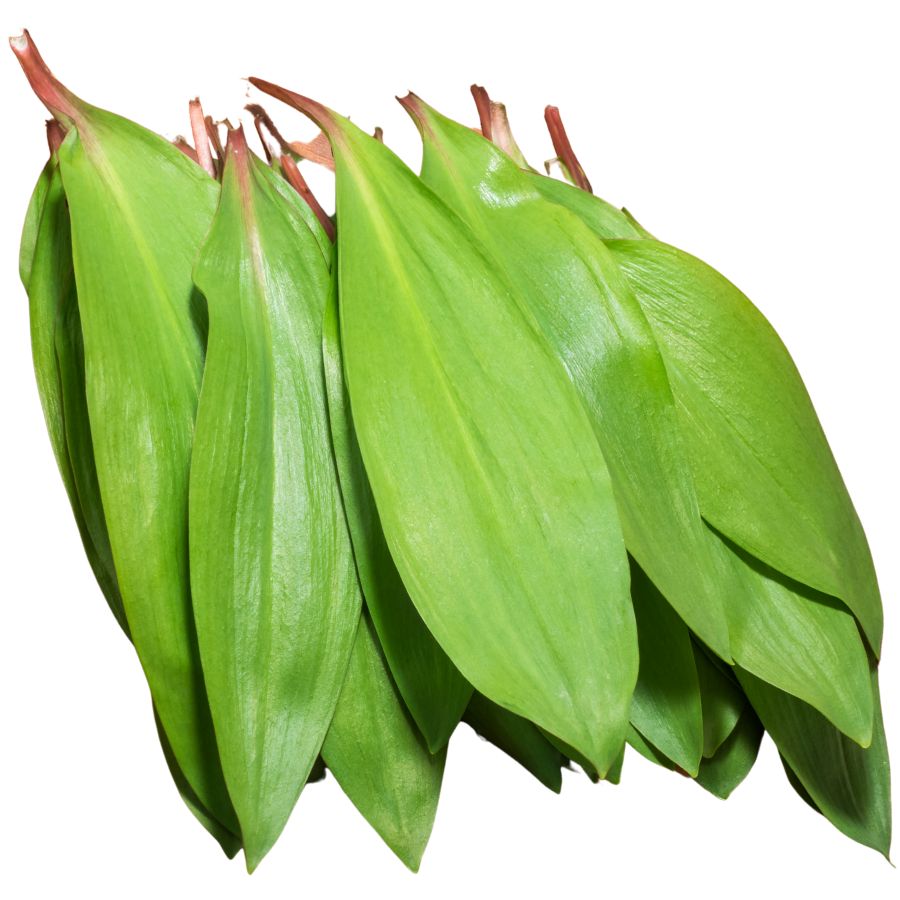
Known as wild leek, ramp, or ramson, this flavorful plant is famous for its broad green leaves and slender white stems. It grows low to the ground and gives off a strong onion-like scent when bruised, which can help you tell it apart from toxic lookalikes like lily of the valley.
If you give it a taste, you will notice a bold mix of onion and garlic flavors, with a tender texture that softens even more when cooked. People often sauté the leaves and stems, pickle the bulbs, or blend them into pestos and soups.
The entire plant can be used for cooking, but the leaves and bulbs are the most prized parts. It is important not to confuse it with similar-looking plants that do not have the signature onion smell when crushed.
Wild leek populations have declined in some areas because of overharvesting, so it is a good idea to only take a few from any given patch. When harvested thoughtfully, these vibrant greens can add a punch of flavor to just about anything you make.
Blackberry (Rubus spp.)
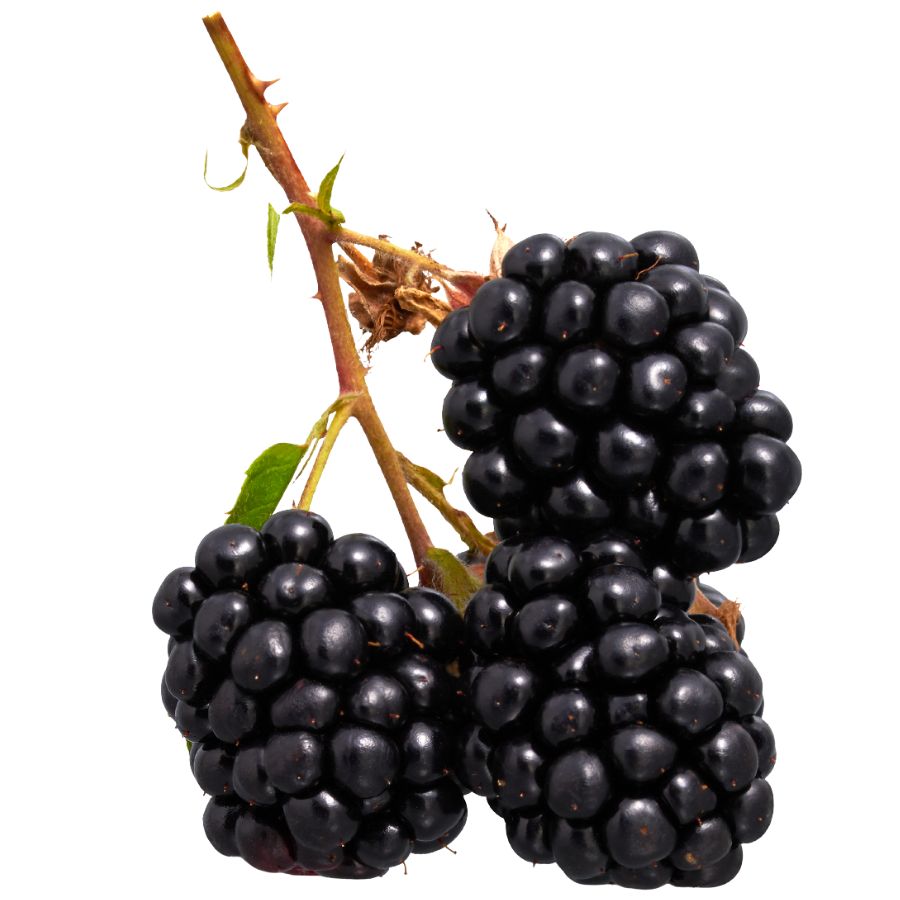
Blackberry, also known as brambleberry or dewberry, grows on thick, thorny canes that can arch and spread across the ground. The leaves are usually serrated, and the fruit ripens from green to red before turning deep purple or black when fully ready to pick.
The berries have a sweet, tangy flavor with a soft, juicy texture that easily bursts in your mouth. You can eat them raw, bake them into pies and cobblers, or preserve them by making jams and jellies.
Only the ripe fruit of the blackberry plant is edible, while the stems and leaves are not usually eaten.
Some plants like black raspberry can look similar, but black raspberries are hollow in the center when picked while blackberries have a solid core. It’s important to avoid confusing blackberries with nightshade berries, which grow on upright plants without thorny vines and can be toxic.
An interesting thing about blackberries is that they are technically not a single berry but a cluster of small drupelets packed together.
Stinging Nettle (Urtica dioica)

Stinging nettle is also known as burn weed or devil leaf, and it definitely earns those names. The tiny hairs on its leaves and stems can leave a painful, tingling rash if you brush against it raw, so always wear gloves when handling it.
Once it’s cooked or dried, those stingers lose their punch, and the leaves turn mild and slightly earthy in flavor. The texture softens too, making it a solid substitute for spinach in soups, pastas, or even as a simple sauté.
The young leaves and tender tops are what you want to collect. Avoid the tough lower stems and older leaves, which can be gritty or unpleasant to chew.
Some people confuse stinging nettle with purple deadnettle or henbit, but those don’t sting and have more rounded, fuzzy leaves. If the plant doesn’t make your skin react, it’s not stinging nettle.
Chicory (Cichorium intybus)
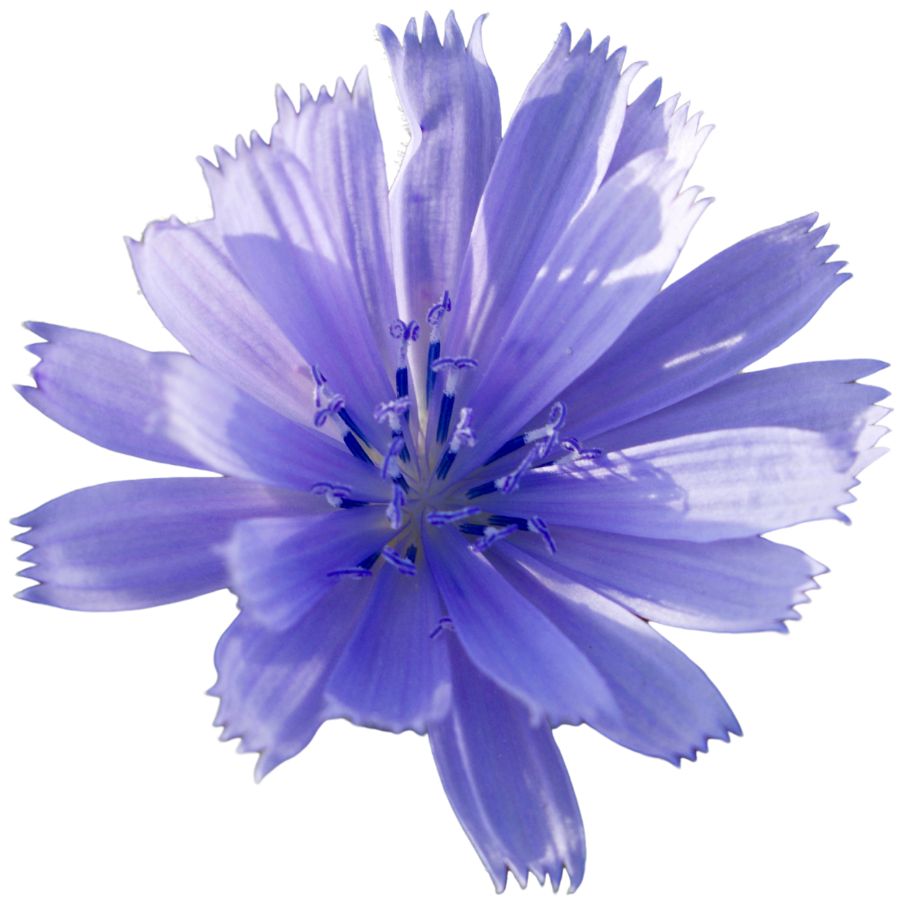
Chicory has bright blue flowers that open in the morning and close by afternoon. Its jagged leaves grow in a rosette close to the ground and can resemble dandelion leaves, but dandelions don’t have the same thick, hairy stems.
The leaves are bitter and slightly earthy, often compared to dandelion greens but with a stronger flavor. You can blanch or sauté them to mellow the bitterness, or chop them raw into salads if you like a sharper bite.
Its roots are the most commonly used part, especially when roasted and ground to mix into coffee or brewed as a caffeine-free drink on their own. They’re dense and woody, and once roasted, they take on a toasty, nutty flavor that balances well with richer foods.
Avoid confusing chicory with wild lettuce, which can grow in similar areas but has a milky sap and a more unpleasant taste. Chicory doesn’t have any toxic lookalikes, but the strong bitterness of mature leaves can be off-putting if you’re not expecting it.
Curly Dock (Rumex crispus)
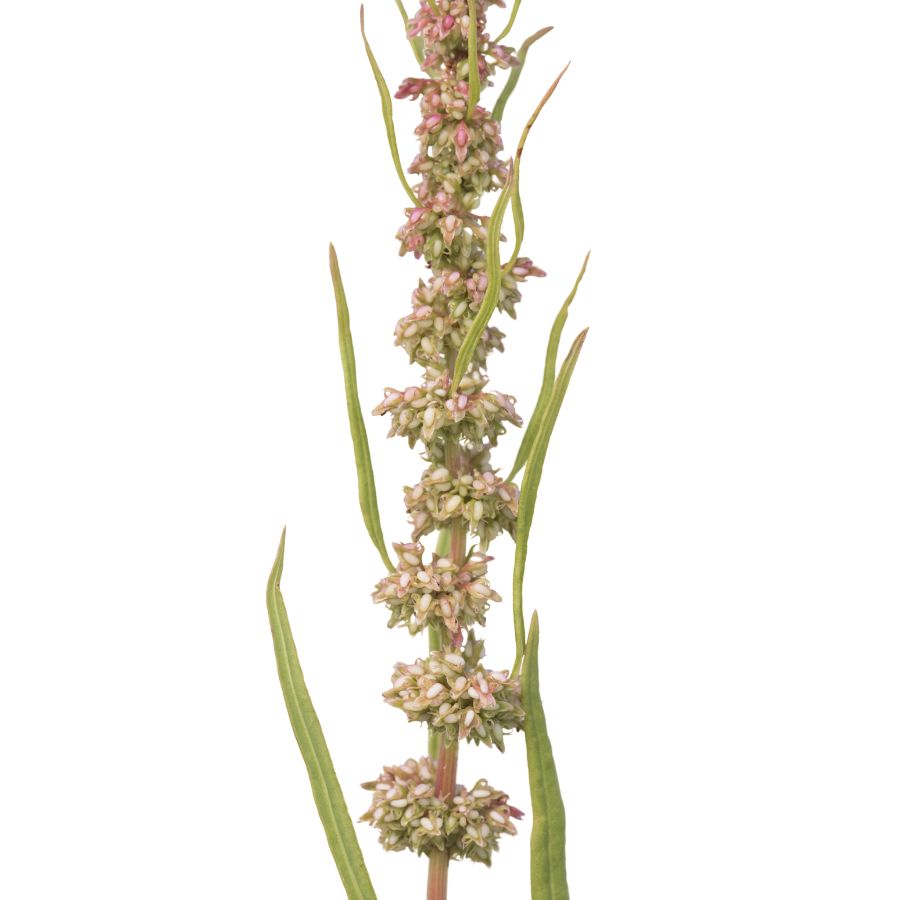
Curly dock, sometimes called yellow dock, is easy to spot once you know what to look for. It has long, wavy-edged leaves that form a rosette at the base, with tall stalks that eventually turn rusty brown as seeds mature.
The young leaves are edible and often cooked to mellow out their sharp, lemony taste, which can be too strong when eaten raw. You can also dry and powder the seeds to use as a flour supplement, although they are tiny and take some effort to prepare.
Curly dock has some lookalikes, like other types of dock and sorrel, but its heavily crinkled leaf edges and thick taproot help it stand out. Be careful not to confuse it with plants like wild rhubarb, which can have toxic parts if misidentified.
Besides being edible, curly dock has a history of being used in homemade remedies for skin irritation. The roots are not eaten raw because they are tough and contain compounds that can upset your stomach if you are not careful.
Garlic Mustard (Alliaria petiolata)
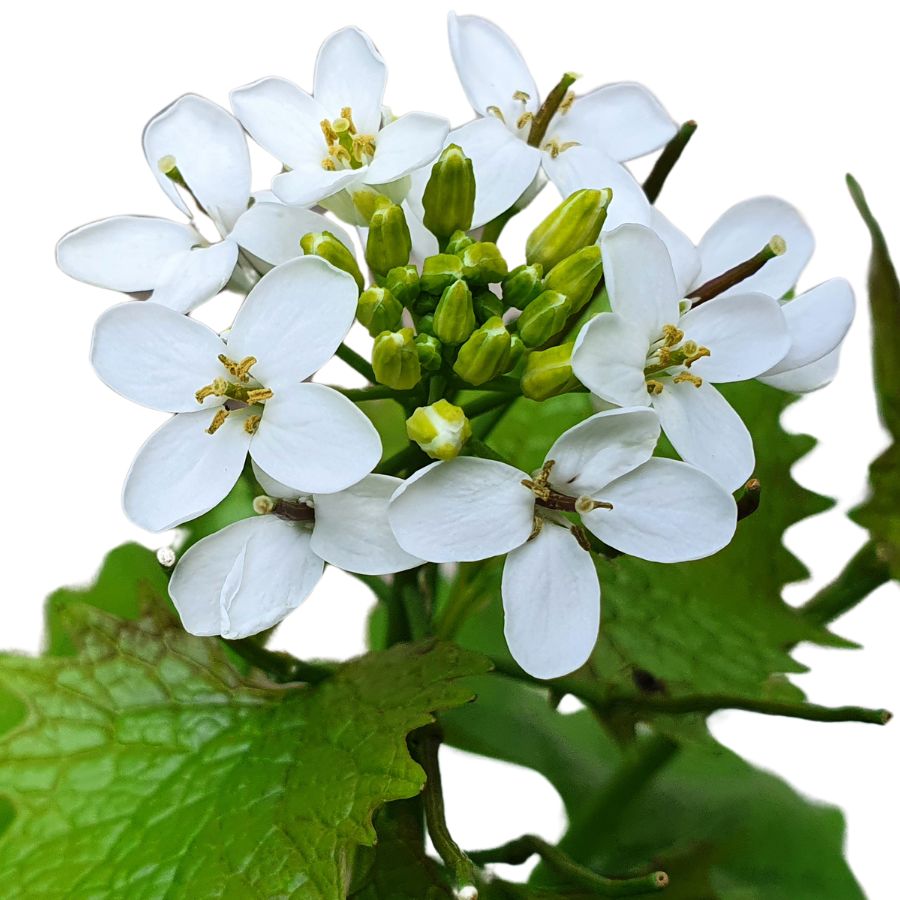
Garlic mustard, sometimes called poor man’s mustard or hedge garlic, has heart-shaped leaves with scalloped edges and small white four-petaled flowers. When you crush the leaves between your fingers, they release a strong garlic-like smell that makes it stand out from similar-looking plants.
The flavor of garlic mustard is sharp and garlicky at first bite, with a peppery bitterness that lingers. Its young leaves are often blended into pestos, stirred into soups, or tossed into salads to add a punch of flavor.
You can also use the roots, which have a taste similar to horseradish when fresh. The seed pods are sometimes collected and used as a spicy seasoning after being dried and crushed.
If you decide to gather some, make sure not to confuse it with plants like ground ivy or purple deadnettle, which do not have that garlic aroma. Stick to harvesting the leaves, flowers, seeds, and roots, and avoid anything with a fuzzy texture or a very different smell.
Acorns (Quercus spp.)
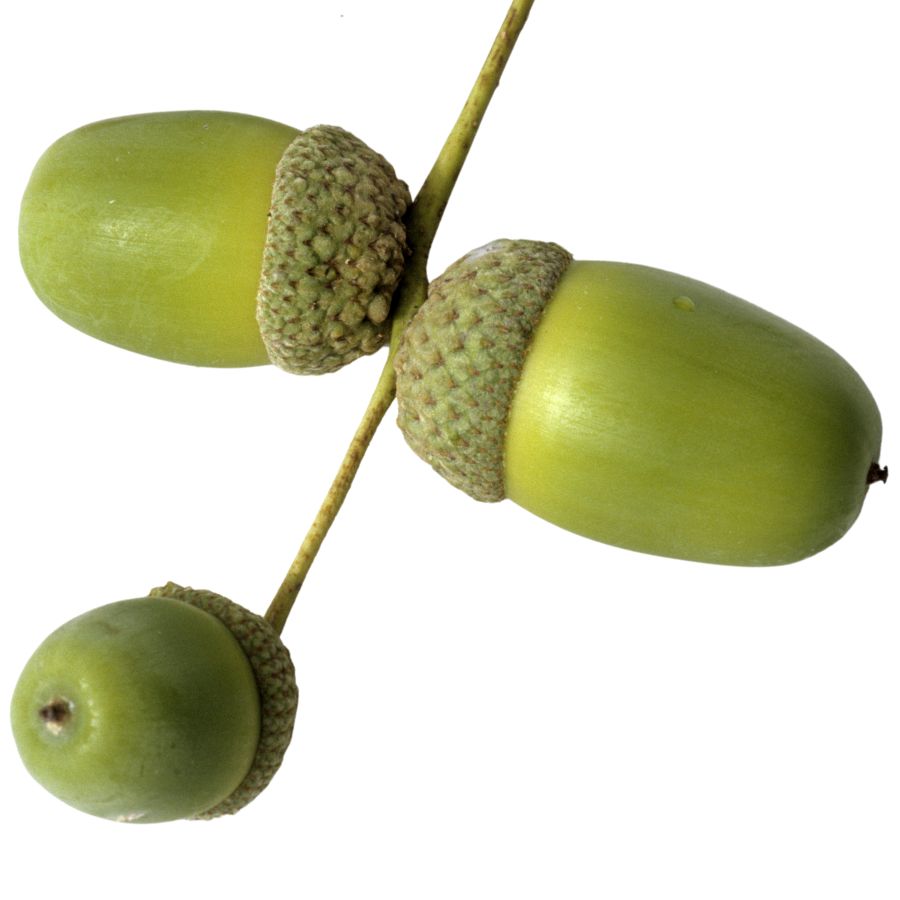
There are different types of oak trees, such as live oaks, white oaks, black oaks, and more. Oak trees are generally are easy to spot by their sturdy trunks and lobed leaves.
Their acorns are the edible part, though you have to properly prepare them to safely enjoy their nutty flavor.
Some types of acorns are very bitter because of high tannin levels, but leaching them in water removes the bitterness. When prepared correctly, acorns can be ground into a sweet, nutty flour that works well for baking or thickening stews.
Besides being a food source, acorns have been used traditionally to make coffee substitutes and animal feed. However, it is important to avoid eating raw acorns because the tannins can cause digestive issues if they are not properly removed.
Be careful not to confuse true oaks with plants like horse chestnuts, which produce similar-looking nuts that are toxic. One way to tell the difference is that true oak acorns have a distinctive, rough-textured cap, while horse chestnuts do not.
Mulberry (Morus spp.)
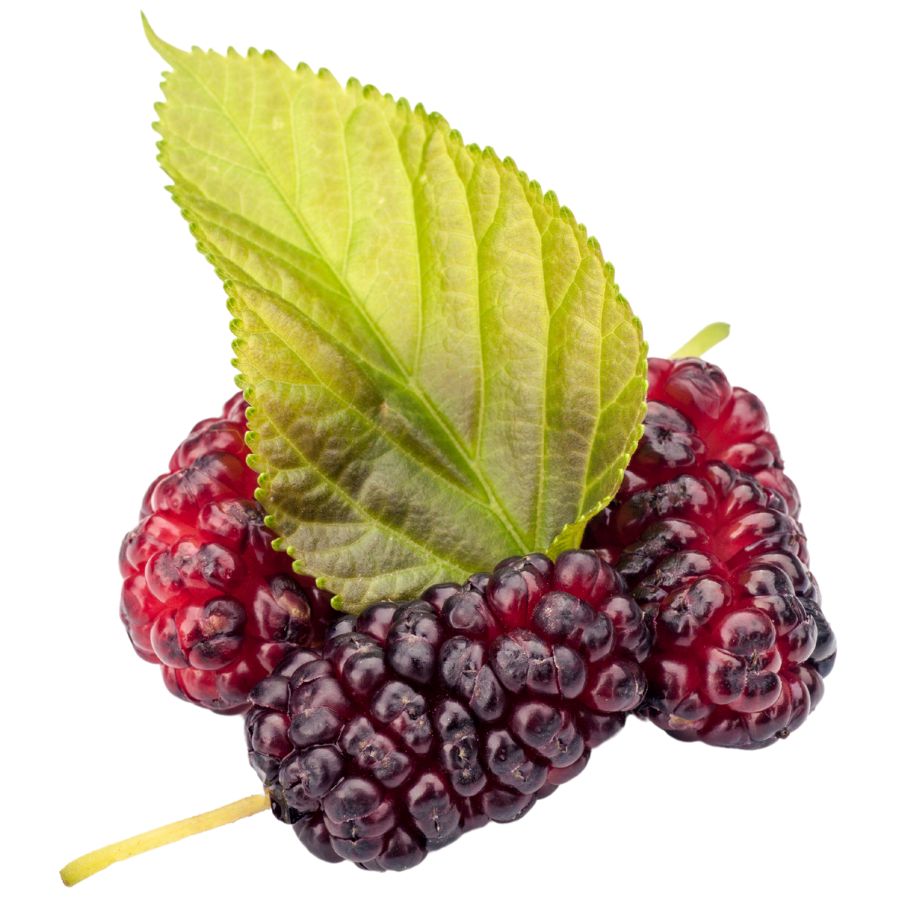
Sweet, juicy, and often overlooked, mulberries are one of the easiest wild berries to recognize. Known by names like white mulberry and red mulberry, these trees produce small, blackberry-like fruits that range from pale pink to deep purple.
The berries have a soft, almost melting texture with a mild tartness behind the sugar. You can eat them fresh by the handful, bake them into pies, or simmer them down into homemade jams and syrups.
While the fruits are safe and delicious when ripe, you should avoid eating the unripe berries or any part of the tree’s sap, which can cause stomach upset. It is also worth knowing that mulberries are delicate and bruise easily when picked, so handle them gently.
Red osier dogwood and some honeysuckles can produce berries that look similar from a distance, but true mulberries grow singly or in loose clusters along the branches and have a distinctive leaf shape that sets them apart. Always double-check the leaf texture and berry arrangement before eating any wild fruits.
Lamb’s Quarters (Chenopodium album)
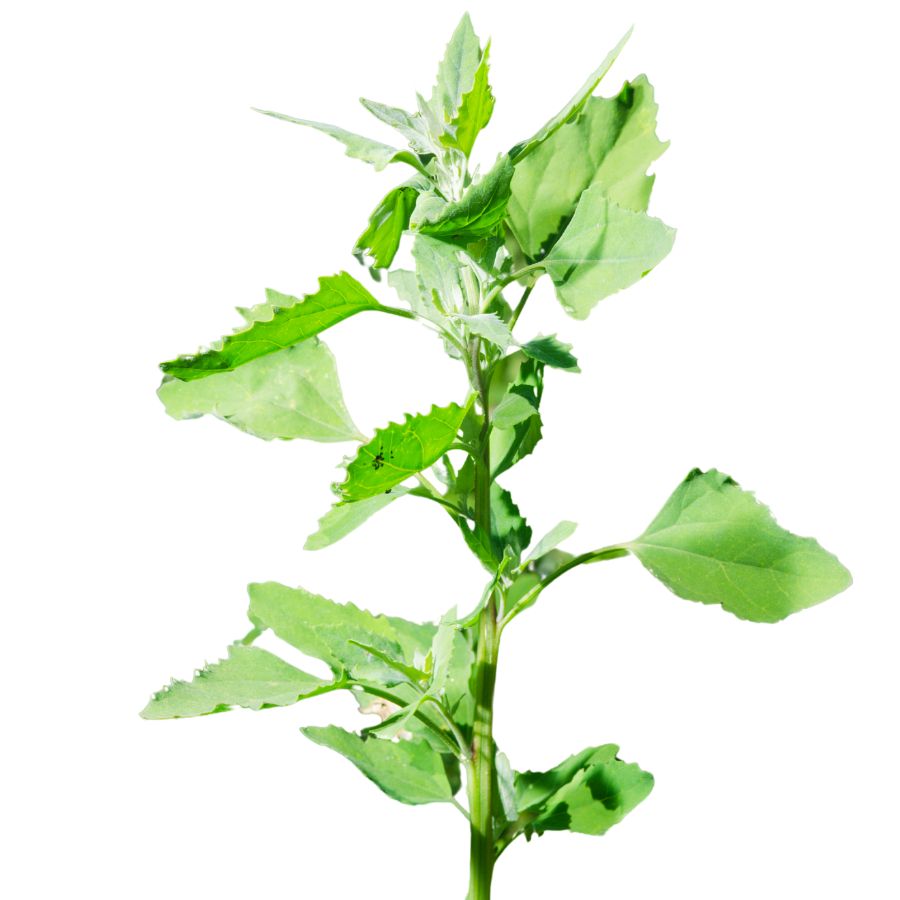
Lamb’s quarters, also called wild spinach and pigweed, has soft green leaves that often look dusted with a white, powdery coating. The leaves are shaped a little like goose feet, with slightly jagged edges and a smooth underside that feels almost velvety when you touch it.
A few plants can be confused with lamb’s quarters, like some types of nightshade, but true lamb’s quarters never have berries and its leaves are usually coated in that distinctive white bloom. Always check that the stems are grooved and not round and smooth like the poisonous lookalikes.
When you taste lamb’s quarters, you will notice it has a mild, slightly nutty flavor that gets richer when cooked. The young leaves, tender stems, and even the seeds are all edible, but you should avoid eating the older stems because they become tough and stringy.
People often sauté lamb’s quarters like spinach, blend it into smoothies, or dry the leaves for later use in soups and stews. It is also rich in oxalates, so you will want to cook it before eating large amounts to avoid any problems.
Wood Sorrel (Oxalis stricta)
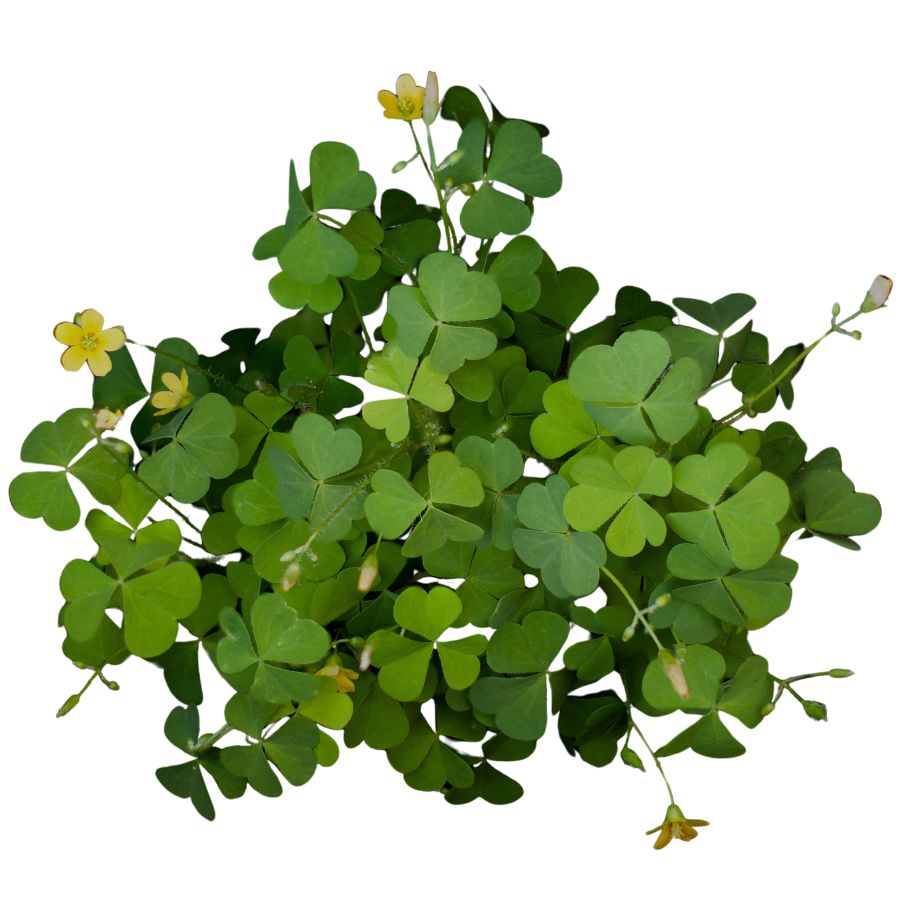
Wood sorrel has clover-like leaves and small yellow flowers. Each leaflet is heart-shaped, and the plant often folds up when touched or in low light.
The leaves, flowers, and seed pods are all safe to eat and have a tart, lemony flavor thanks to the oxalic acid they contain. You can toss them into salads, use them as a garnish, or nibble on them raw for a refreshing sour bite.
Be careful not to confuse it with clover, which has rounder leaves and lacks the same sharp tang when tasted. Large amounts of wood sorrel aren’t recommended if you have kidney issues, since oxalic acid can be hard on the kidneys over time.
The texture of the leaves is soft and delicate, making them a nice contrast in dishes with heavier greens. Even the seed pods have a bit of crunch and a pleasant tang if you catch them before they dry out.
Black Walnut (Juglans nigra)
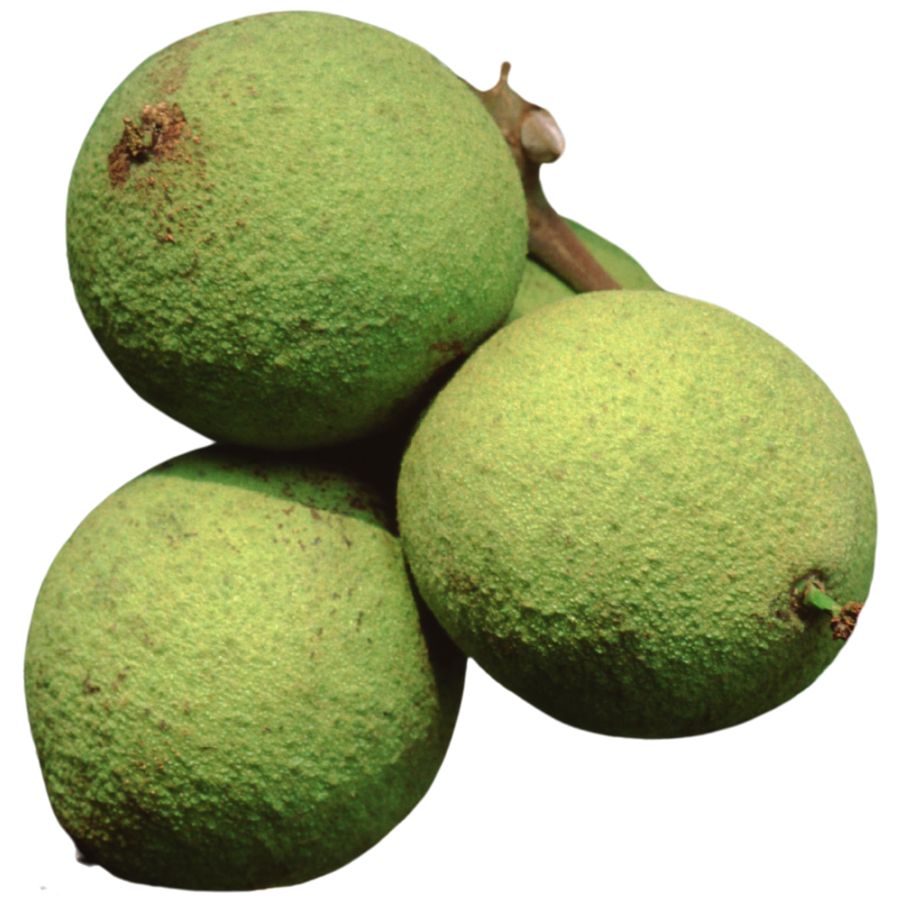
The nuts of the black walnut, sometimes called American walnut or eastern black walnut, have a tough outer husk and a deeply ridged shell inside. When you crack them open, you will find a rich, oily seed with an earthy, slightly bitter flavor that sets them apart from the sweeter English walnut.
It is easy to confuse black walnut with butternut, another tree with compound leaves and rough bark. If you check the nuts closely, black walnut fruits are round with a thick green husk, while butternuts are more oval and sticky.
When you get your hands on the nuts, the common ways to prepare them include baking them into cookies, sprinkling them over salads, or grinding them into a strong-tasting flour. The seeds themselves have a firm, almost chewy texture when raw and become crunchy after roasting.
Only the inner seed is eaten, while the outer husk and shell are discarded because they contain compounds that can irritate your skin. A fun fact about this plant is that even the roots and leaves produce a chemical called juglone, which can make it hard for other plants to grow nearby.
Watercress (Nasturtium officinale)
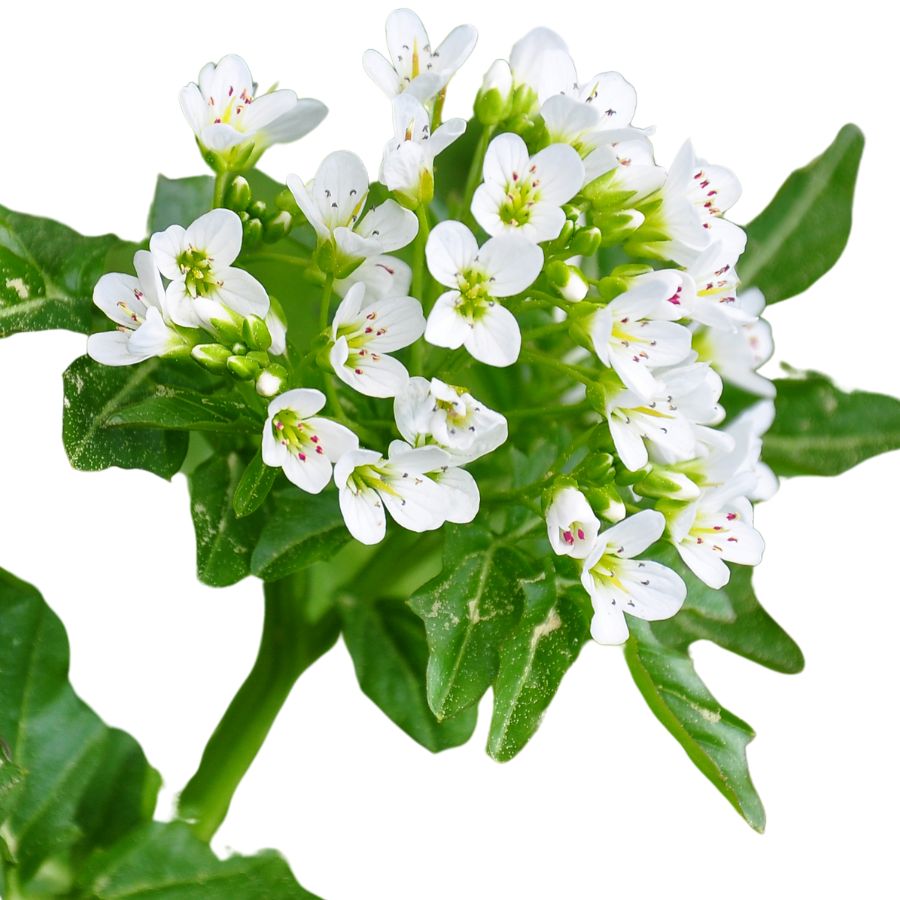
Watercress, also known as yellowcress or garden cress, is an aquatic plant with small, rounded green leaves and hollow stems that often float along the water’s surface. It usually grows in dense mats, and the bright green color is one of the easiest ways to spot it in clear, shallow streams and ponds.
Besides being a popular edible green, watercress has been traditionally used in herbal remedies, especially for boosting digestion and respiratory health.
The leaves and stems are edible, offering a crisp texture and a peppery, slightly spicy taste that can remind you of arugula. People often enjoy it raw in salads, blended into soups, or lightly wilted into stir-fries for a fresh bite.
Stick to eating the leaves and stems, and avoid any parts that look yellowed or slimy, since healthy watercress should always look vibrant and clean.
Watercress has a few lookalikes like lesser celandine or young wild mustard, but true watercress has a distinct sharp flavor and tends to grow only in moving, clean water. Always double-check your identification, because gathering from stagnant or contaminated water sources can expose you to harmful bacteria or parasites.
Elderberry (Sambucus nigra subsp. canadensis)
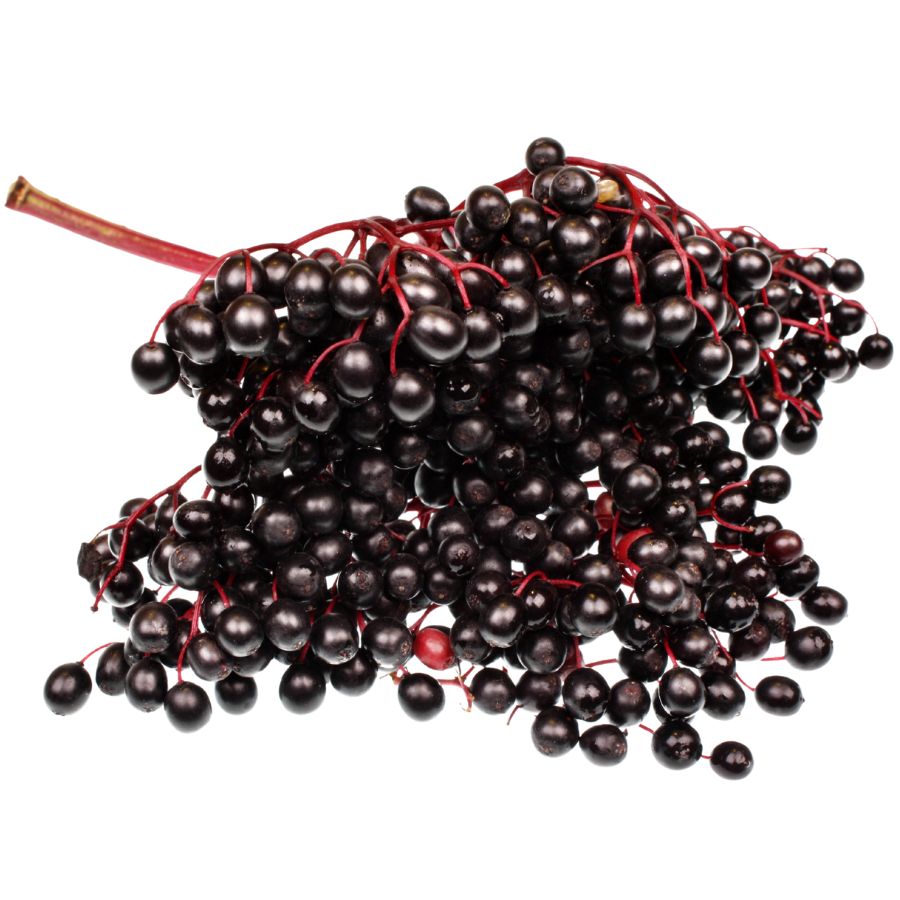
Elderberry is often called American elder, common elder, or sweet elder. It grows as a large, shrubby plant with clusters of tiny white flowers that eventually turn into deep purple to black berries.
You can recognize elderberry by its compound leaves with five to eleven serrated leaflets and its flat-topped flower clusters. One important thing to watch out for is its toxic lookalikes, like pokeweed, which has very different smooth-edged leaves and reddish stems.
The ripe berries have a tart, almost earthy flavor and a soft texture when cooked. People usually cook elderberries into syrups, jams, pies, or wine because eating raw berries can cause nausea.
Only the ripe, cooked berries and flowers are edible, while the leaves, stems, and unripe berries are toxic. Always take care to strip the berries cleanly from their stems before using them, as even small bits of stem can cause problems.
Plantain (Plantago major)

Plantain, also called common plantain or narrowleaf plantain depending on the type, is a low-growing plant with broad or lance-shaped leaves and tall, slender flower spikes. The leaves grow in a rosette close to the ground, and the thick veins running through them are one of the easiest ways to tell it apart from other plants.
You can mainly eat the young leaves and the seeds of the plants. Older leaves can become tough and stringy, so it is best to pick the smaller, tender ones when you want to eat them.
Plantain leaves have a slightly bitter, earthy taste and a chewy texture, especially when eaten raw. Many people like to add them to salads, soups, or stews, or lightly steam them to soften the flavor.
Always make sure you have a true plantain before eating because some similar-looking yard plants are not palatable and can upset your stomach. Look for the strong parallel veins and the tough, fibrous stems to help confirm your find.
Jerusalem Artichoke (Helianthus tuberosus)
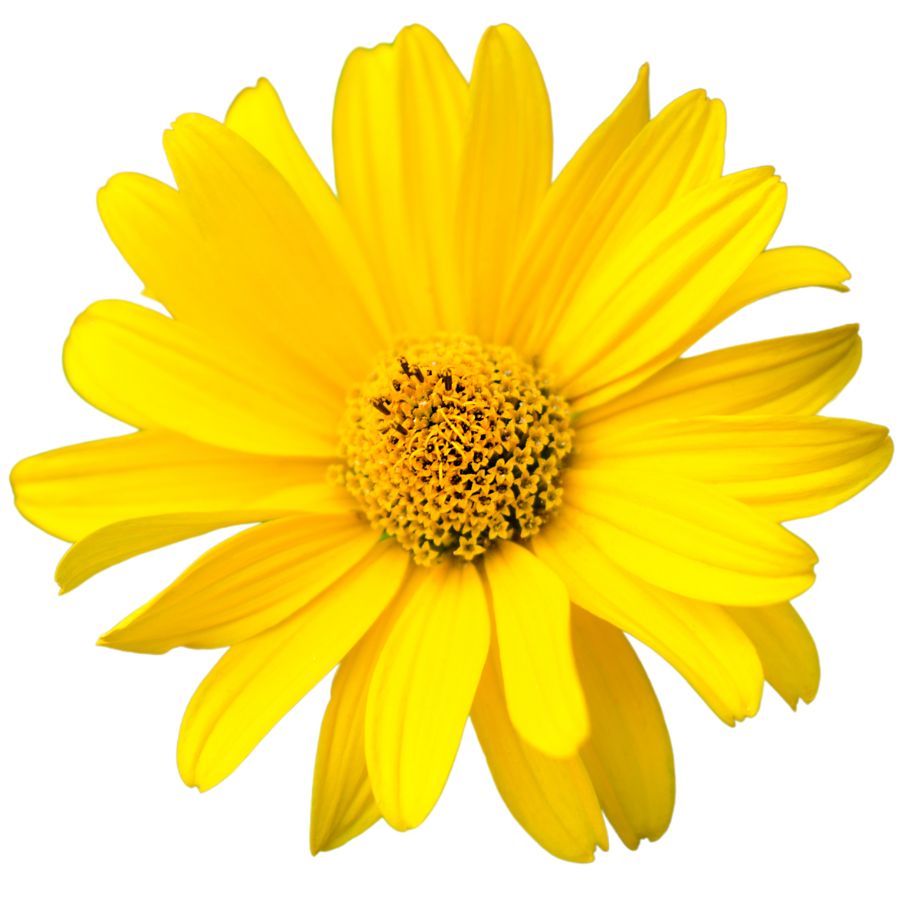
Jerusalem artichoke grows tall with sunflower-like blooms and has knobby underground tubers. The tubers are tan or reddish and look a bit like ginger root, though they belong to the sunflower family.
The part you’re after is the tuber, which has a nutty, slightly sweet flavor and a crisp texture when raw. You can roast, sauté, boil, or mash them like potatoes, and they hold their shape well in soups and stir-fries.
Some people experience gas or bloating after eating sunchokes due to the inulin they contain, so it’s a good idea to try a small amount first. Cooking them thoroughly can help reduce the chances of digestive discomfort.
Sunchokes don’t have many dangerous lookalikes, but it’s important not to confuse the plant with other sunflower relatives that don’t produce tubers. The above-ground part resembles a small sunflower, but it’s the knotted, underground tubers that are worth digging up.
Toxic Plants That Look Like Edible Plants
There are plenty of wild edibles to choose from, but some toxic native plants closely resemble them. Mistaking the wrong one can lead to severe illness or even death, so it’s important to know exactly what you’re picking.
Poison Hemlock (Conium maculatum)
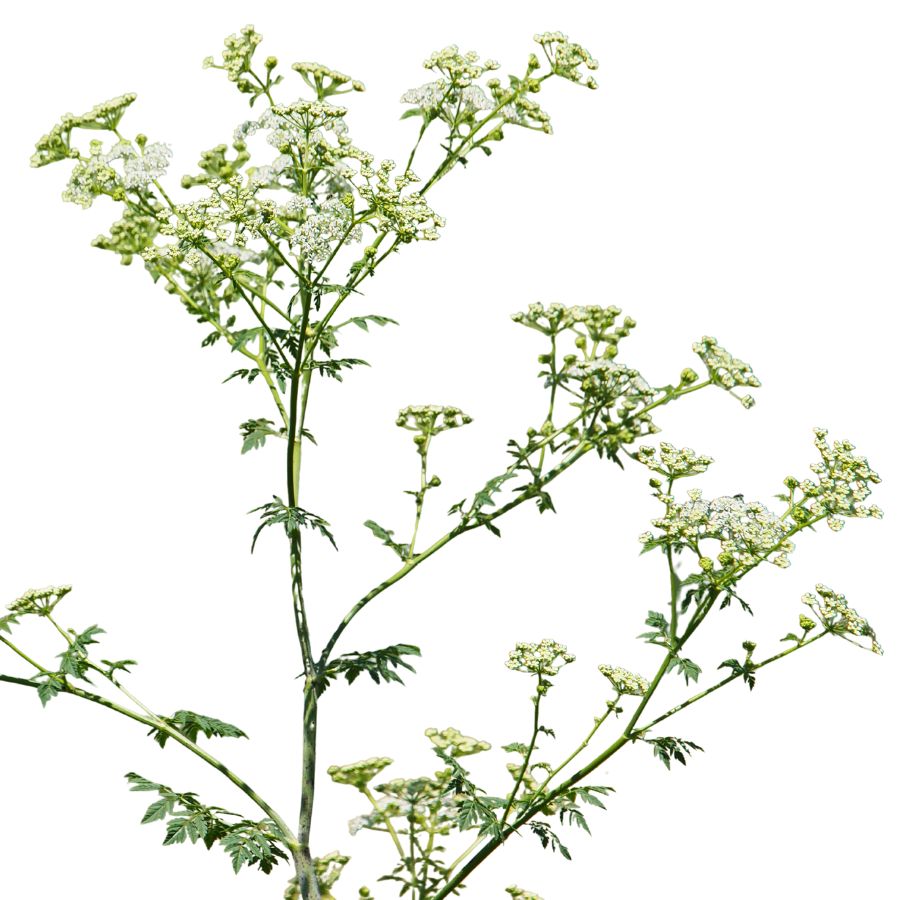
Often mistaken for: Wild carrot (Daucus carota)
Poison hemlock is a tall plant with lacy leaves and umbrella-like clusters of tiny white flowers. It has smooth, hollow stems with purple blotches and grows in sunny places like roadsides, meadows, and stream banks.
Unlike wild carrot, which has hairy stems and a dark central floret, poison hemlock has a musty odor and no flower center spot. It’s extremely toxic; just a small amount can be fatal, and even touching the sap can irritate the skin.
Water Hemlock (Cicuta spp.)
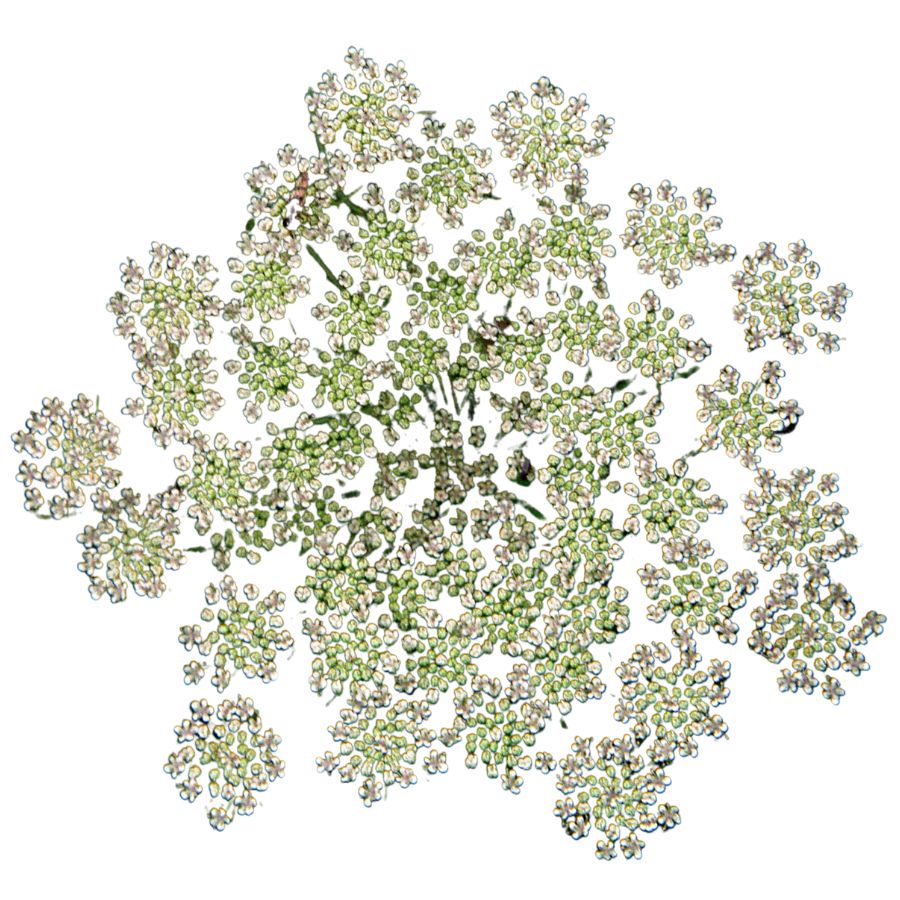
Often mistaken for: Wild parsnip (Pastinaca sativa) or wild celery (Apium spp.)
Water hemlock is a tall, branching plant with umbrella-shaped clusters of small white flowers. It grows in wet places like stream banks, marshes, and ditches, with stems that often show purple streaks or spots.
It can be confused with wild parsnip or wild celery, but its thick, hollow roots have internal chambers and release a yellow, foul-smelling sap when cut. Water hemlock is the most toxic plant in North America, and just a small amount can cause seizures, respiratory failure, and death.
False Hellebore (Veratrum viride)
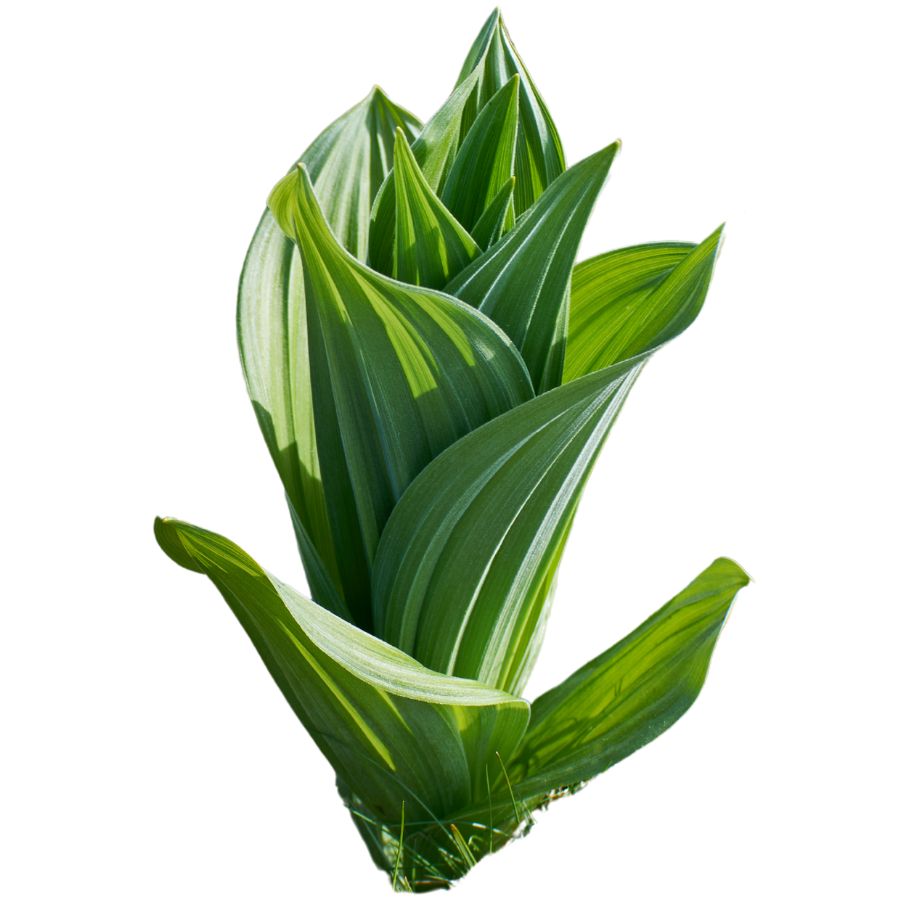
Often mistaken for: Ramps (Allium tricoccum)
False hellebore is a tall plant with broad, pleated green leaves that grow in a spiral from the base, often appearing early in spring. It grows in moist woods, meadows, and along streams.
It’s commonly mistaken for ramps, but ramps have a strong onion or garlic smell, while false hellebore is odorless and later grows a tall flower stalk. The plant is highly toxic, and eating any part can cause nausea, a slowed heart rate, and even death due to its alkaloids that affect the nervous and cardiovascular systems.
Death Camas (Zigadenus spp.)
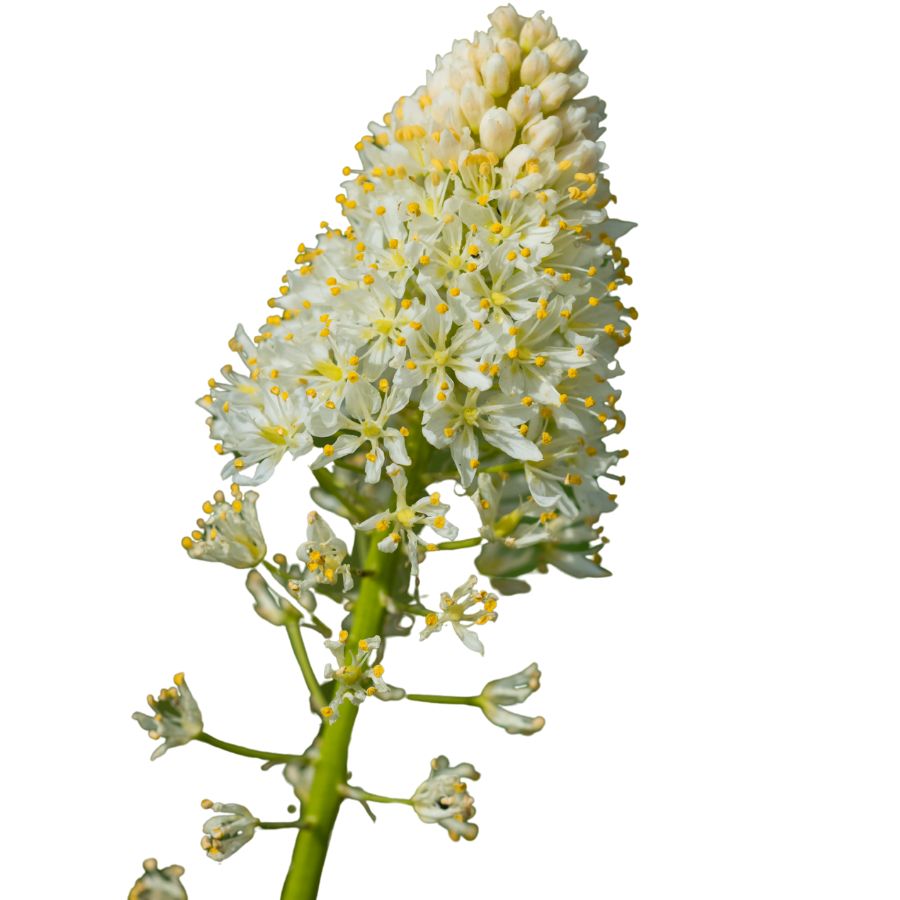
Often mistaken for: Wild onion or wild garlic (Allium spp.)
Death camas is a slender, grass-like plant that grows from underground bulbs and is found in open woods, meadows, and grassy hillsides. It has small, cream-colored flowers in loose clusters atop a tall stalk.
It’s often confused with wild onion or wild garlic due to their similar narrow leaves and habitats, but only Allium plants have a strong onion or garlic scent, while death camas has none. The plant is extremely poisonous, especially the bulbs, and even a small amount can cause nausea, vomiting, a slowed heartbeat, and potentially fatal respiratory failure.
Buckthorn Berries (Rhamnus spp.)
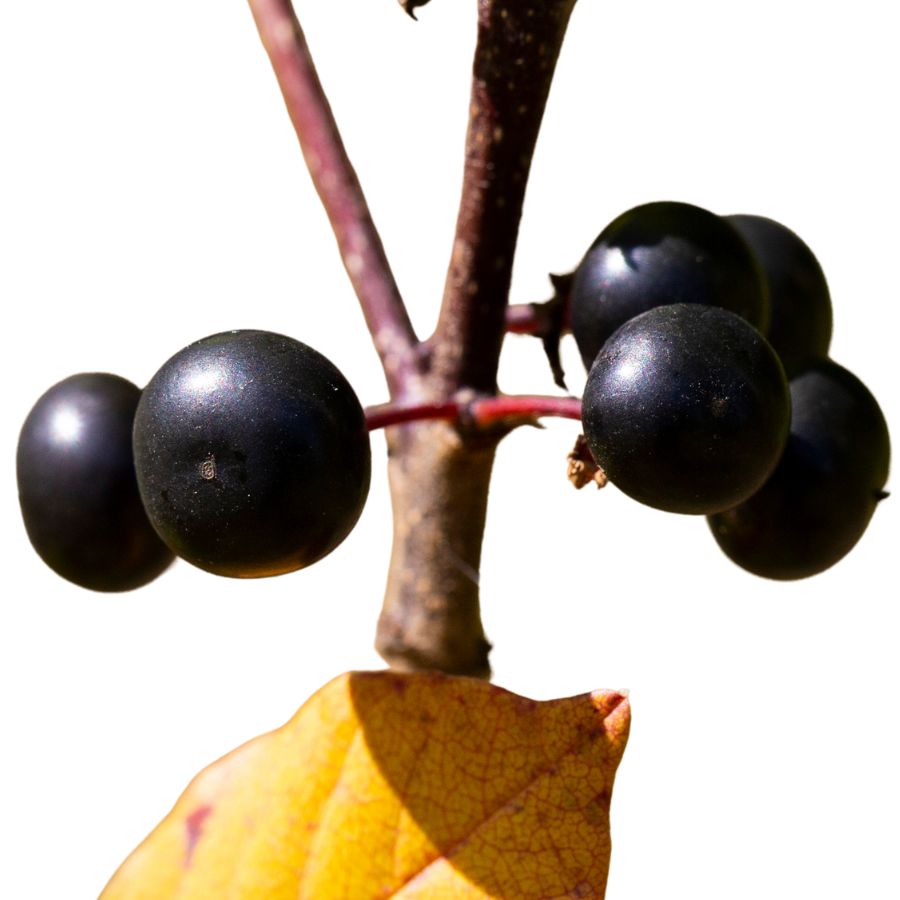
Often mistaken for: Elderberries (Sambucus spp.)
Buckthorn is a shrub or small tree often found along woodland edges, roadsides, and disturbed areas. It produces small, round berries that ripen to dark purple or black and usually grow in loose clusters.
These berries are sometimes mistaken for elderberries and other wild fruits, which also grow in dark clusters, but elderberries form flat-topped clusters on reddish stems while buckthorn berries are more scattered. Buckthorn berries are unsafe to eat as they contain compounds that can cause cramping, vomiting, and diarrhea, and large amounts may lead to dehydration and serious digestive problems.
Mayapple (Podophyllum peltatum)
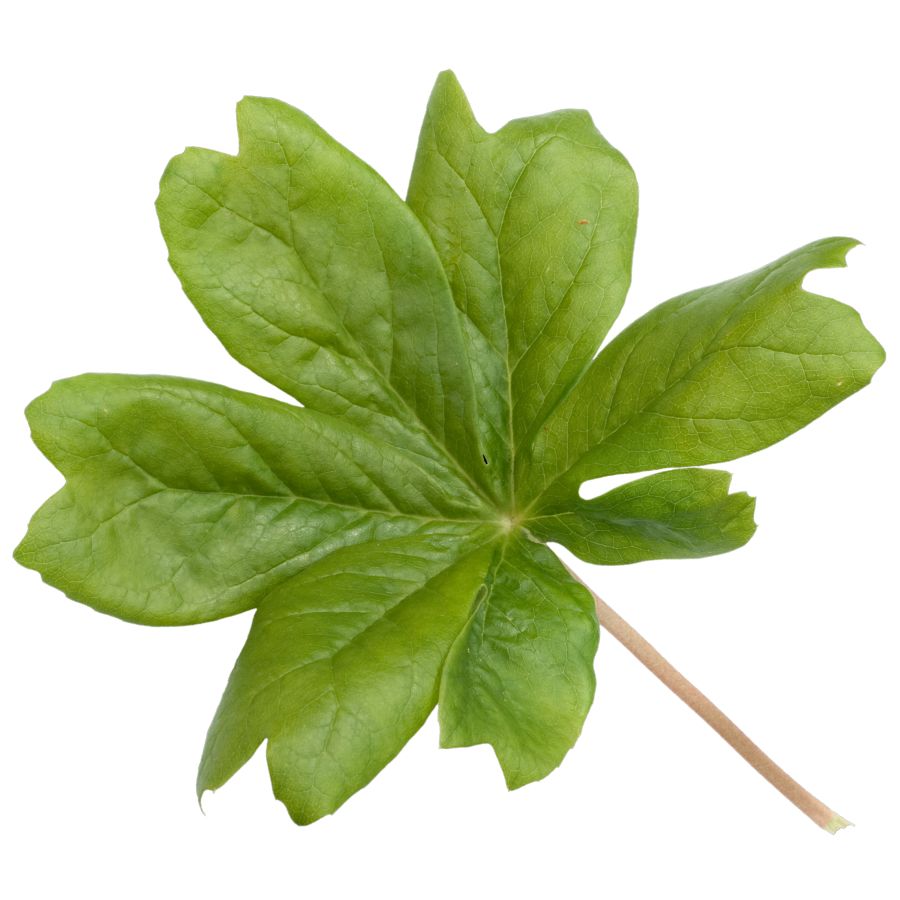
Often mistaken for: Wild grapes (Vitis spp.)
Mayapple is a low-growing plant found in shady forests and woodland clearings. It has large, umbrella-like leaves and produces a single pale fruit hidden beneath the foliage.
The unripe fruit resembles a small green grape, causing confusion with wild grapes, which grow in woody clusters on vines. All parts of the mayapple are toxic except the fully ripe, yellow fruit, which is only safe in small amounts. Eating unripe fruit or other parts can lead to nausea, vomiting, and severe dehydration.
Virginia Creeper (Parthenocissus quinquefolia)
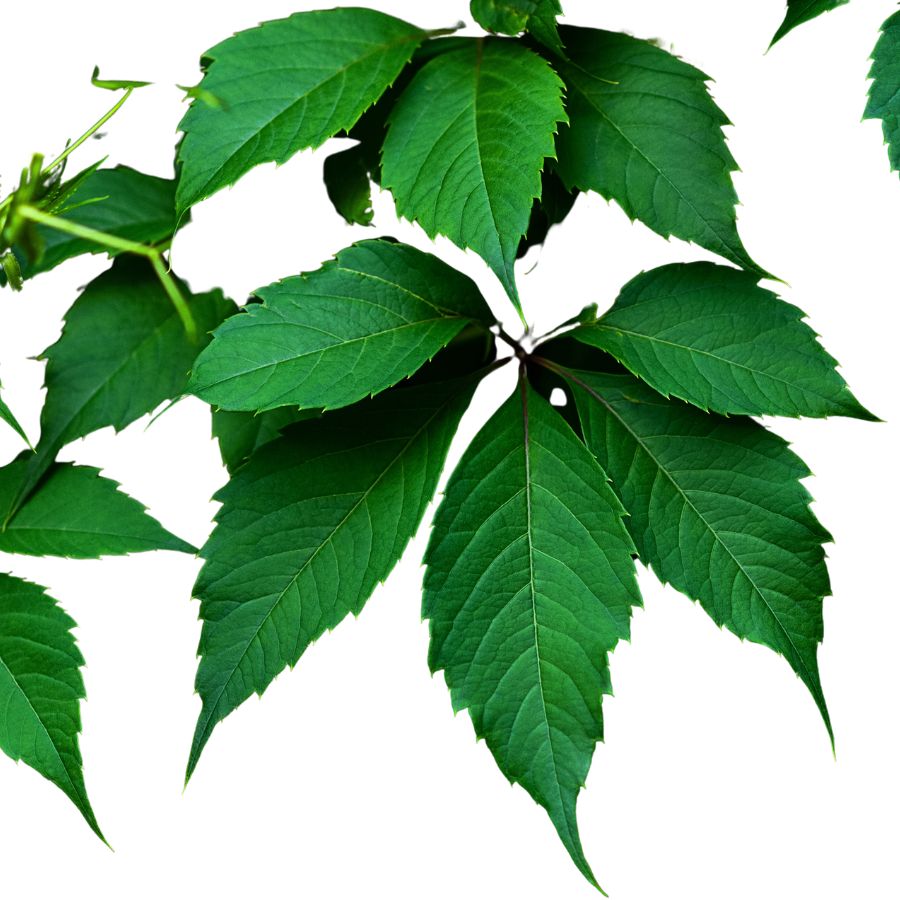
Often mistaken for: Wild grapes (Vitis spp.)
Virginia creeper is a fast-growing vine found on fences, trees, and forest edges. It has five leaflets per stem and produces small, bluish-purple berries from late summer to fall.
It’s often confused with wild grapes since both are climbing vines with similar berries, but grapevines have large, lobed single leaves and tighter fruit clusters. Virginia creeper’s berries are toxic to humans and contain oxalate crystals that can cause nausea, vomiting, and throat irritation.
Castor Bean (Ricinus communis)
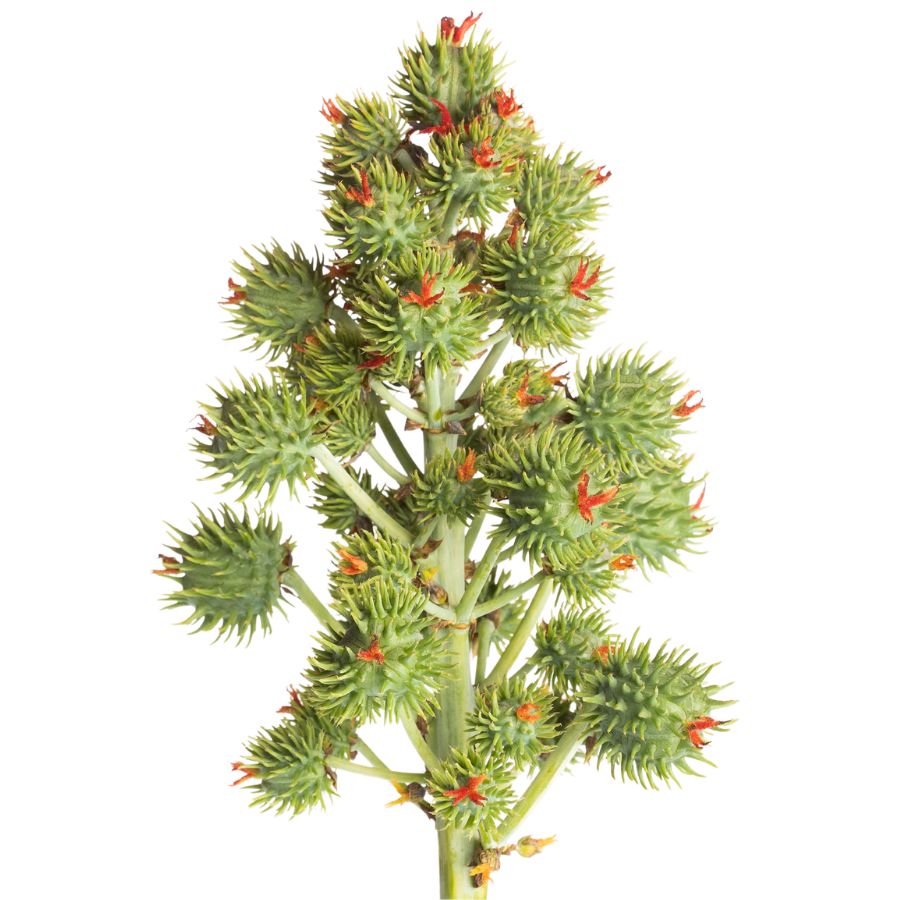
Often mistaken for: Wild rhubarb (Rumex spp. or Rheum spp.)
Castor bean is a bold plant with large, lobed leaves and tall red or green stalks, often found in gardens, along roadsides, and in disturbed areas in warmer regions in the US. Its red-tinged stems and overall size can resemble wild rhubarb to the untrained eye.
Unlike rhubarb, castor bean plants produce spiny seed pods containing glossy, mottled seeds that are extremely toxic. These seeds contain ricin, a deadly compound even in small amounts. While all parts of the plant are toxic, the seeds are especially dangerous and should never be handled or ingested.
A Quick Reminder
Before we get into the specifics about where and how to find these mushrooms, we want to be clear that before ingesting any wild mushroom, it should be identified with 100% certainty as edible by someone qualified and experienced in mushroom identification, such as a professional mycologist or an expert forager. Misidentification of mushrooms can lead to serious illness or death.
All mushrooms have the potential to cause severe adverse reactions in certain individuals, even death. If you are consuming mushrooms, it is crucial to cook them thoroughly and properly and only eat a small portion to test for personal tolerance. Some people may have allergies or sensitivities to specific mushrooms, even if they are considered safe for others.
The information provided in this article is for general informational and educational purposes only. Foraging for wild mushrooms involves inherent risks.
How to Get the Best Results Foraging
Safety should always come first when it comes to foraging. Whether you’re in a rural forest or a suburban greenbelt, knowing how to harvest wild foods properly is a key part of staying safe and respectful in the field.
Always Confirm Plant ID Before You Harvest Anything
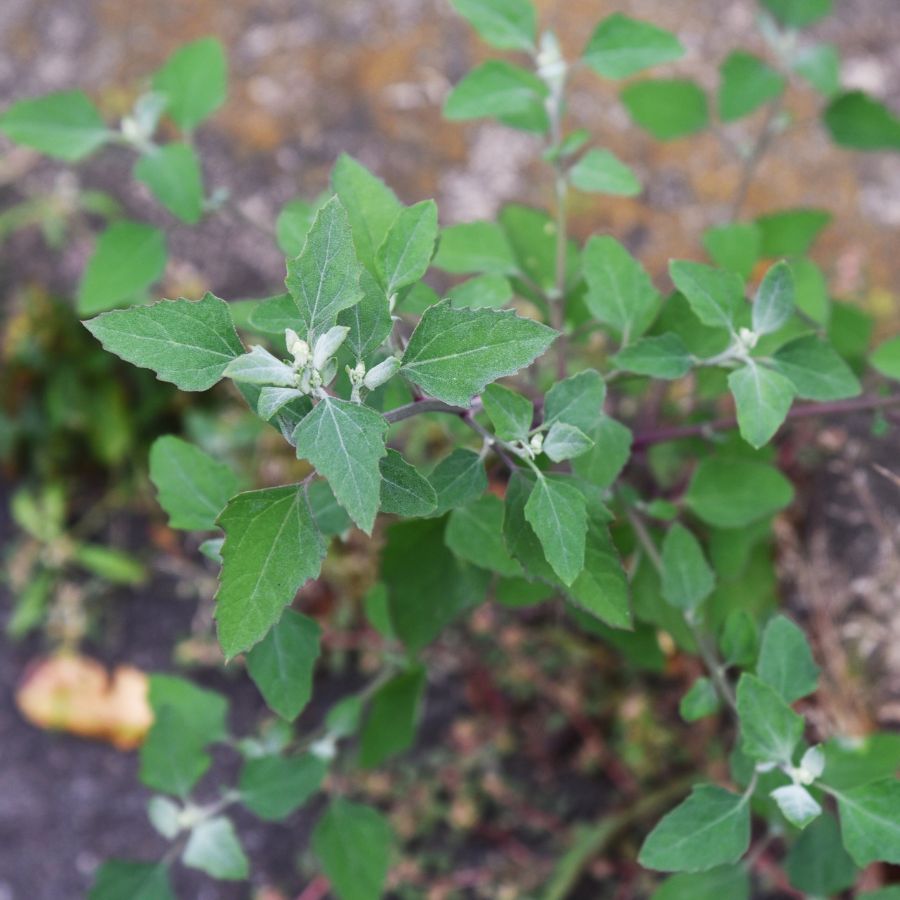
Knowing exactly what you’re picking is the most important part of safe foraging. Some edible plants have nearly identical toxic lookalikes, and a wrong guess can make you seriously sick.
Use more than one reliable source to confirm your ID, like field guides, apps, and trusted websites. Pay close attention to small details. Things like leaf shape, stem texture, and how the flowers or fruits are arranged all matter.
Not All Edible Plants Are Safe to Eat Whole
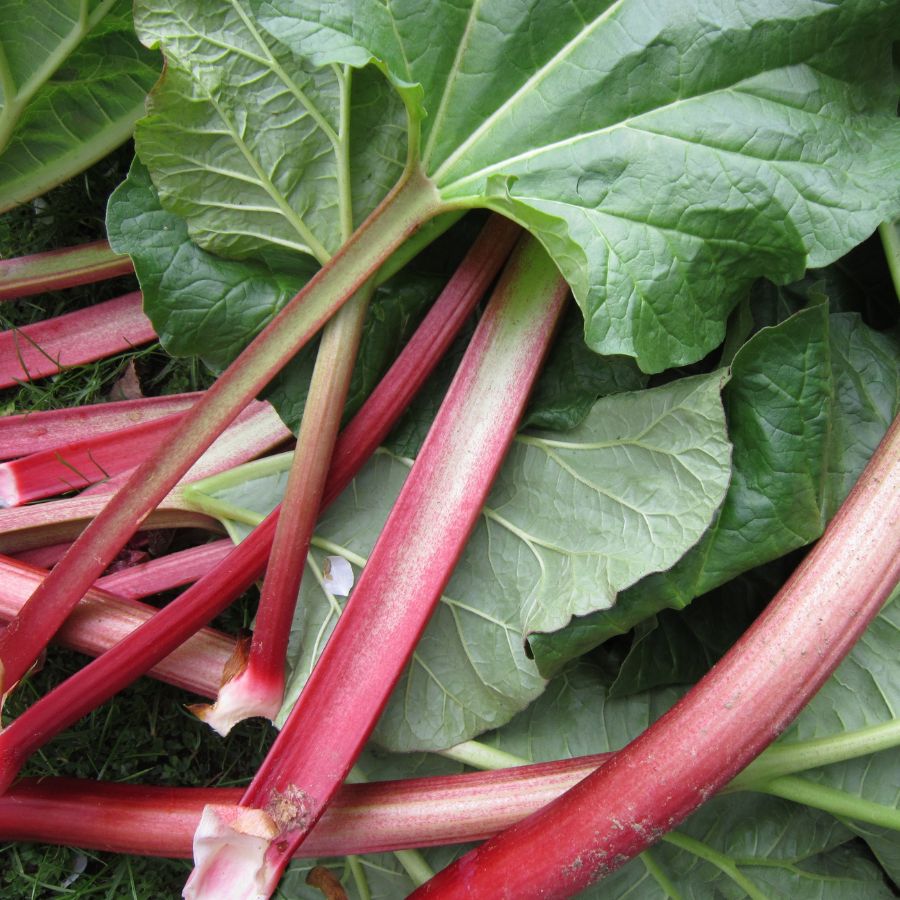
Just because a plant is edible doesn’t mean every part of it is safe. Some plants have leaves, stems, or seeds that can be toxic if eaten raw or prepared the wrong way.
For example, pokeweed is only safe when young and properly cooked, while elderberries need to be heated before eating. Rhubarb stems are fine, but the leaves are poisonous. Always look up which parts are edible and how they should be handled.
Avoid Foraging in Polluted or Contaminated Areas
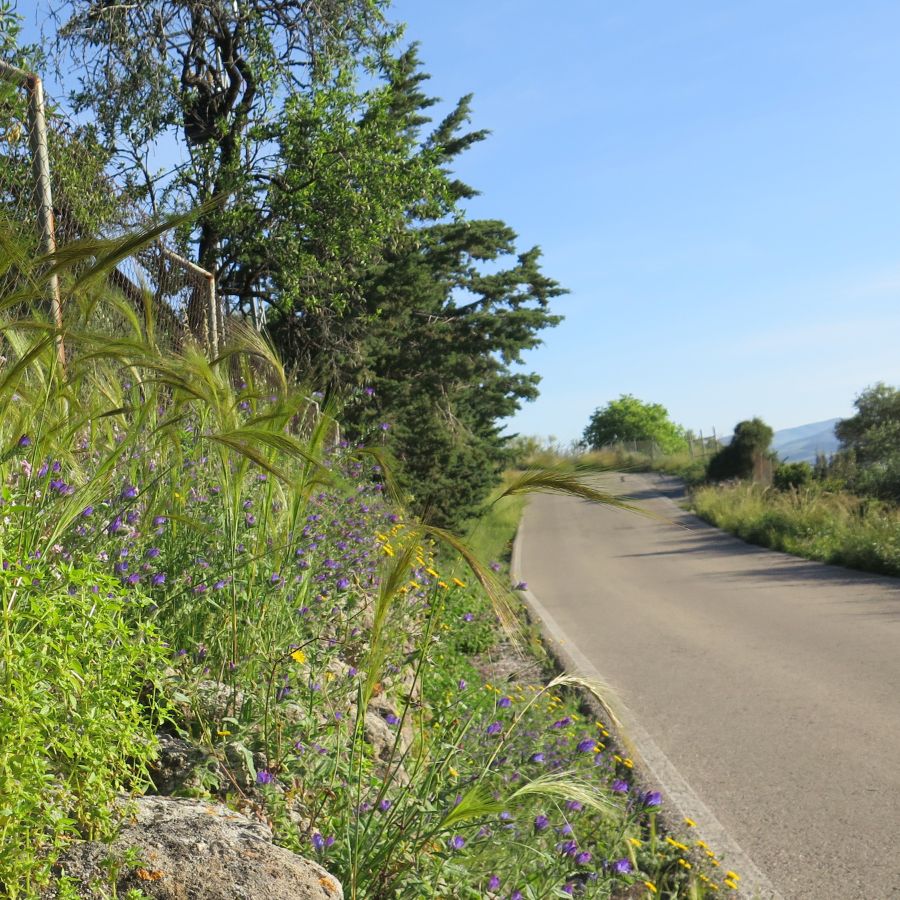
Where you forage matters just as much as what you pick. Plants growing near roads, buildings, or farmland might be coated in chemicals or growing in polluted soil.
Even safe plants can take in harmful substances from the air, water, or ground. Stick to clean, natural areas like forests, local parks that allow foraging, or your own yard when possible.
Don’t Harvest More Than What You Need
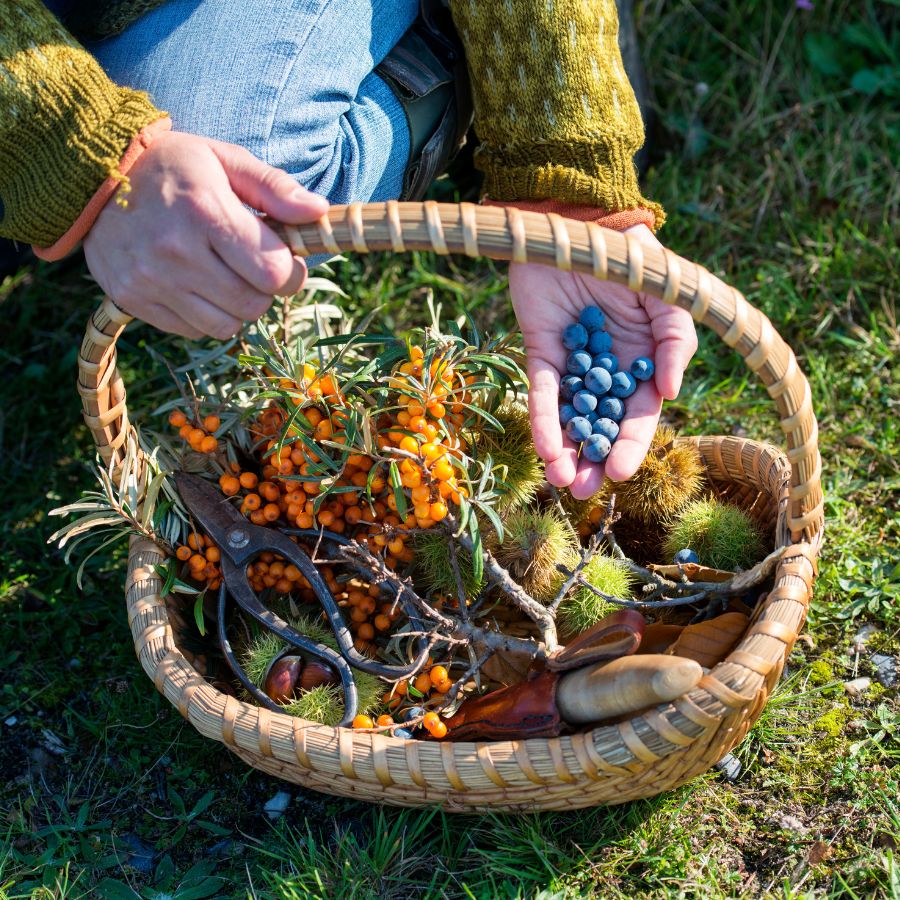
When you forage, take only what you plan to use. Overharvesting can hurt local plant populations and reduce future growth in that area.
Leaving plenty behind helps plants reproduce and supports wildlife that depends on them. It also ensures other foragers have a chance to enjoy the same resources.
Protect Yourself and Your Finds with Proper Foraging Gear
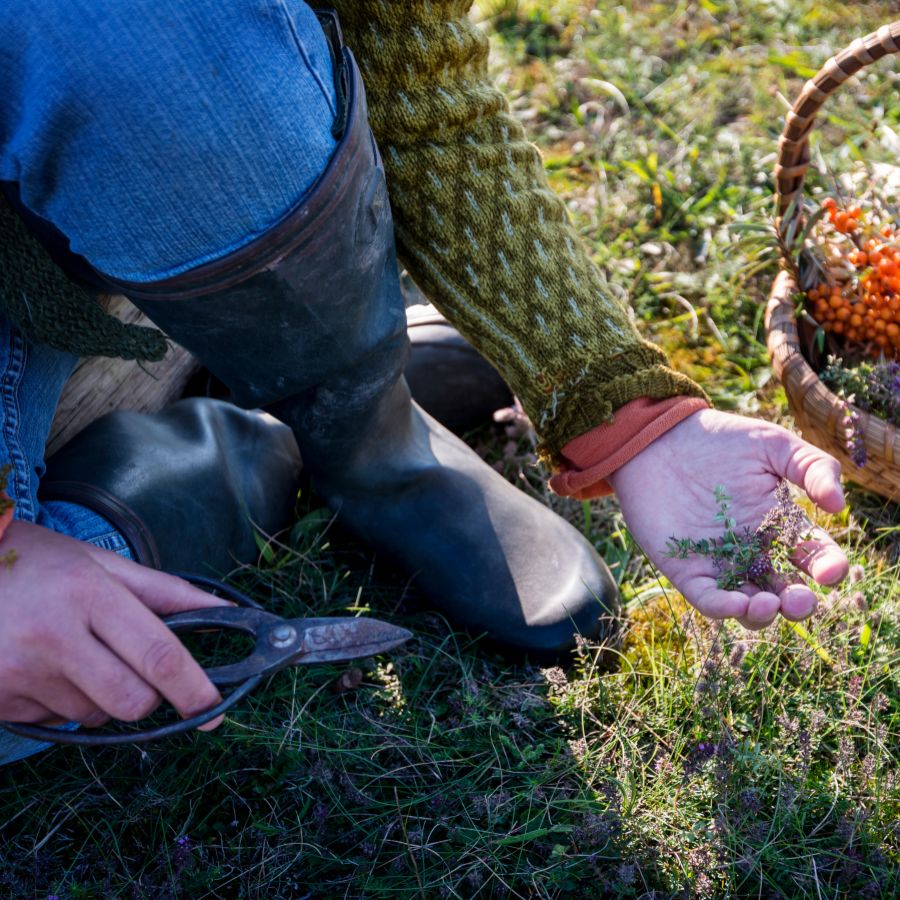
Having the right tools makes foraging easier and safer. Gloves protect your hands from irritants like stinging nettle, and a good knife or scissors lets you harvest cleanly without damaging the plant.
Use a basket or breathable bag to carry what you collect. Plastic bags hold too much moisture and can cause your greens to spoil before you get home.
This forager’s toolkit covers the essentials for any level of experience.
Watch for Allergic Reactions When Trying New Wild Foods

Even if a wild plant is safe to eat, your body might react to it in unexpected ways. It’s best to try a small amount first and wait to see how you feel.
Be extra careful with kids or anyone who has allergies. A plant that’s harmless for one person could cause a reaction in someone else.
Check Local Rules Before Foraging on Any Land
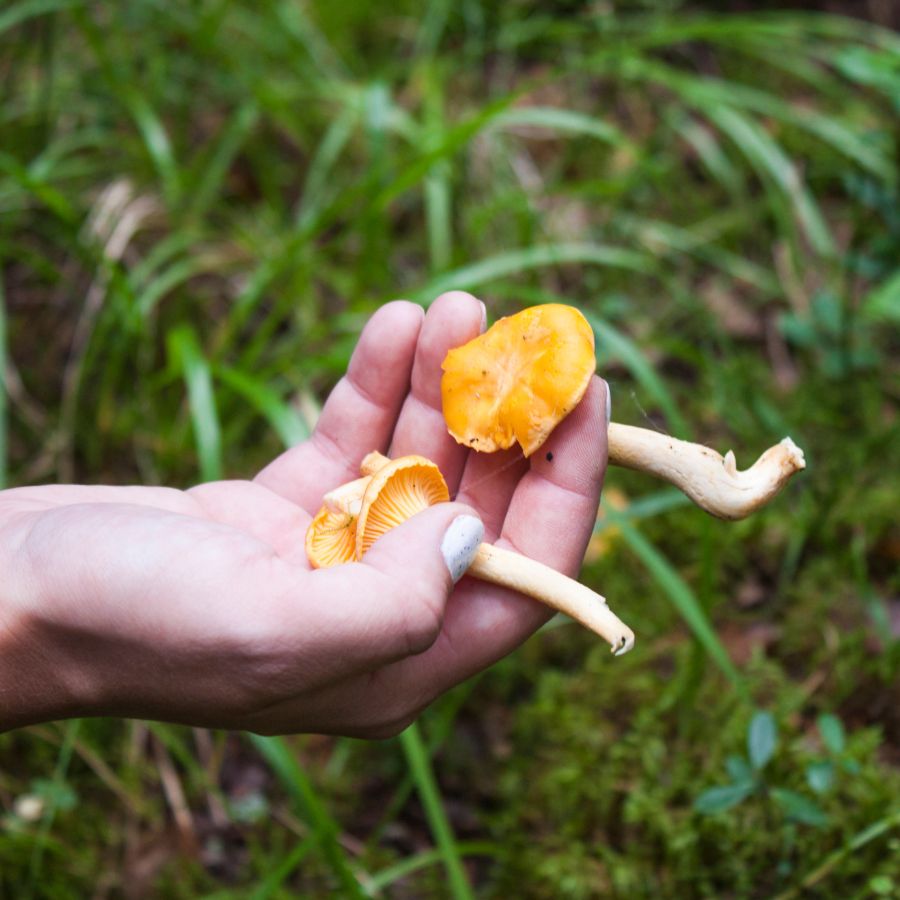
Before you start foraging, make sure you know the rules for the area you’re in. What’s allowed in one spot might be completely off-limits just a few miles away.
Some public lands permit limited foraging, while others, like national parks, usually don’t allow it at all. If you’re on private property, always get permission first.
Before you head out
Before embarking on any foraging activities, it is essential to understand and follow local laws and guidelines. Always confirm that you have permission to access any land and obtain permission from landowners if you are foraging on private property. Trespassing or foraging without permission is illegal and disrespectful.
For public lands, familiarize yourself with the foraging regulations, as some areas may restrict or prohibit the collection of mushrooms or other wild foods. These regulations and laws are frequently changing so always verify them before heading out to hunt. What we have listed below may be out of date and inaccurate as a result.
Where to Find Forageables in the State
There is a range of foraging spots where edible plants grow naturally and often in abundance:
| Plant | Locations |
| Black Walnut (Juglans nigra) | Mississippi Palisades State Park, Forest Glen Preserve, Matthiessen State Park |
| Hickory Nuts (Carya spp.) | Cache River State Natural Area, Apple River Canyon State Park, Shawnee National Forest |
| Acorns (Quercus spp.) | Ferne Clyffe State Park, Sand Ridge State Forest, Forest Glen Preserve |
| Wild Leek / Ramp (Allium tricoccum) | Salt Lick Point Land and Water Reserve, Matthiessen State Park, Shawnee National Forest |
| Wild Garlic (Allium vineale) | Forest Glen Preserve, Mississippi Palisades State Park, Cache River State Natural Area |
| Wild Onion (Allium canadense) | Giant City State Park, Shawnee National Forest, Ferne Clyffe State Park |
| Garlic Mustard (Alliaria petiolata) | Mississippi Palisades State Park, Apple River Canyon State Park, Forest Glen Preserve |
| Stinging Nettle (Urtica dioica) | Shawnee National Forest, Cache River State Natural Area, Sand Ridge State Forest |
| Lamb’s Quarters (Chenopodium album) | Salt Lick Point Land and Water Reserve, Forest Glen Preserve, Matthiessen State Park |
| Amaranth (Amaranthus spp.) | Cache River State Natural Area, Shawnee National Forest, Ferne Clyffe State Park |
| Wood Sorrel (Oxalis stricta) | Sand Ridge State Forest, Apple River Canyon State Park, Forest Glen Preserve |
| Dandelion (Taraxacum officinale) | Shawnee National Forest, Mississippi Palisades State Park, Giant City State Park |
| Chicory (Cichorium intybus) | Matthiessen State Park, Ferne Clyffe State Park, Cache River State Natural Area |
| Sheep Sorrel (Rumex acetosella) | Sand Ridge State Forest, Forest Glen Preserve, Apple River Canyon State Park |
| Curly Dock (Rumex crispus) | Shawnee National Forest, Salt Lick Point Land and Water Reserve, Giant City State Park |
| Plantain (Plantago major) | Ferne Clyffe State Park, Mississippi Palisades State Park, Sand Ridge State Forest |
| Broadleaf Dock (Rumex obtusifolius) | Matthiessen State Park, Shawnee National Forest, Apple River Canyon State Park |
| Common Mallow (Malva neglecta) | Cache River State Natural Area, Forest Glen Preserve, Giant City State Park |
| Common Blue Violet (Viola sororia) | Salt Lick Point Land and Water Reserve, Ferne Clyffe State Park, Shawnee National Forest |
| Jewelweed (Impatiens capensis) | Apple River Canyon State Park, Giant City State Park, Matthiessen State Park |
| Common Milkweed (Asclepias syriaca) | Sand Ridge State Forest, Shawnee National Forest, Mississippi Palisades State Park |
| Daylily (Hemerocallis fulva) | Ferne Clyffe State Park, Matthiessen State Park, Forest Glen Preserve |
| Cattail (Typha spp.) | Cache River State Natural Area, Shawnee National Forest, Mississippi Palisades State Park |
| Jerusalem Artichoke (Helianthus tuberosus) | Salt Lick Point Land and Water Reserve, Giant City State Park, Sand Ridge State Forest |
| Groundnut (Apios americana) | Shawnee National Forest, Apple River Canyon State Park, Ferne Clyffe State Park |
| Wild Bergamot (Monarda fistulosa) | Mississippi Palisades State Park, Matthiessen State Park, Forest Glen Preserve |
| Spicebush (Lindera benzoin) | Cache River State Natural Area, Giant City State Park, Shawnee National Forest |
| Wild Grape (Vitis riparia) | Apple River Canyon State Park, Salt Lick Point Land and Water Reserve, Sand Ridge State Forest |
| Pawpaw (Asimina triloba) | Shawnee National Forest, Ferne Clyffe State Park, Cache River State Natural Area |
| Elderberry (Sambucus nigra subsp. canadensis) | Salt Lick Point Land and Water Reserve, Shawnee National Forest, Giant City State Park |
| Blackberry (Rubus spp.) | Mississippi Palisades State Park, Matthiessen State Park, Sand Ridge State Forest |
| Raspberry (Rubus idaeus) | Forest Glen Preserve, Shawnee National Forest, Apple River Canyon State Park |
| Dewberry (Rubus flagellaris) | Ferne Clyffe State Park, Cache River State Natural Area, Giant City State Park |
| Mulberry (Morus spp.) | Sand Ridge State Forest, Forest Glen Preserve, Matthiessen State Park |
| Persimmon (Diospyros virginiana) | Shawnee National Forest, Salt Lick Point Land and Water Reserve, Cache River State Natural Area |
| Mayapple (Podophyllum peltatum) | Apple River Canyon State Park, Giant City State Park, Shawnee National Forest |
| Redbud Flowers (Cercis canadensis) | Mississippi Palisades State Park, Forest Glen Preserve, Matthiessen State Park |
| Basswood Leaves (Tilia americana) | Ferne Clyffe State Park, Shawnee National Forest, Apple River Canyon State Park |
| Watercress (Nasturtium officinale) | Cache River State Natural Area, Mississippi Palisades State Park, Forest Glen Preserve |
| Field Pennycress (Thlaspi arvense) | Salt Lick Point Land and Water Reserve, Sand Ridge State Forest, Giant City State Park |
| Wild Rose Hips (Rosa spp.) | Matthiessen State Park, Apple River Canyon State Park, Shawnee National Forest |
| Smartweed (Persicaria spp.) | Cache River State Natural Area, Forest Glen Preserve, Mississippi Palisades State Park |
| Wild Lettuce (Lactuca canadensis) | Sand Ridge State Forest, Giant City State Park, Salt Lick Point Land and Water Reserve |
| Common Sunflower (Helianthus annuus) | Ferne Clyffe State Park, Shawnee National Forest, Forest Glen Preserve |
| Goldenrod (Solidago spp.) | Mississippi Palisades State Park, Matthiessen State Park, Sand Ridge State Forest |
Peak Foraging Seasons
Different edible plants grow at different times of year, depending on the season and weather. Timing your search makes all the difference.
Spring
Spring brings a fresh wave of wild edible plants as the ground thaws and new growth begins:
| Plant | Months | Best Weather Conditions |
| Basswood Leaves (Tilia americana) | May | Young leaves in shady moist woods |
| Curly Dock (Rumex crispus) | April–May | Moist soils in sunny areas |
| Field Pennycress (Thlaspi arvense) | April–May | Sunny roadsides and disturbed soil |
| Garlic Mustard (Alliaria petiolata) | April–May | Shady woodland edges in moist soil |
| Mayapple (Podophyllum peltatum) | May | Shady forest understories after rain |
| Redbud Flowers (Cercis canadensis) | April | Sunny woodland edges |
| Common Blue Violet (Viola sororia) | April–May | Moist forest floors or lawns |
| Wild Leek / Ramp (Allium tricoccum) | April–May | Cool, damp hardwood forests |
| Stinging Nettle (Urtica dioica) | April–June | Cool, damp areas, especially near streams |
| Wild Onion (Allium canadense) | April–June | Sunny areas after rain |
| Dandelion (Taraxacum officinale) | March–October | Sunny weather after rainfall |
| Plantain (Plantago major) | May–October | Sunny, compacted soil, post-rain |
| Sheep Sorrel (Rumex acetosella) | April–September | Sandy or acidic soils in dry open areas |
| Watercress (Nasturtium officinale) | March–October | Cold, clean running water |
| Wild Garlic (Allium vineale) | March–October | Wet, disturbed soil in mild weather |
| Wood Sorrel (Oxalis stricta) | April–September | Mild temps with filtered sunlight |
| Broadleaf Dock (Rumex obtusifolius) | April–July | Moist soil near edges of fields or paths |
Summer
Summer is a peak season for foraging, with fruits, flowers, and greens growing in full force:
| Plant | Months | Best Weather Conditions |
| Dewberry (Rubus flagellaris) | May–July | Dry, sunny clearings |
| Goldenrod (Solidago spp.) | August–October | Dry prairies and fields |
| Groundnut (Apios americana) | August–October | Moist woods and streambanks |
| Spicebush (Lindera benzoin) | August–October | Moist, shaded woodlands |
| Wild Grape (Vitis riparia) | August–October | Vine-covered woods in sunny edges |
| Blackberry (Rubus spp.) | July–August | Sunny thickets and woodland edges |
| Cattail (Typha spp.) | June–August | Shallow water or marshy areas |
| Common Milkweed (Asclepias syriaca) | June–August | Sunny meadows and disturbed fields |
| Common Sunflower (Helianthus annuus) | July–August | Open fields under full sun |
| Daylily (Hemerocallis fulva) | June–July | Sunny roadsides and old homesteads |
| Elderberry (Sambucus nigra subsp. canadensis) | July–August | Moist soils and edge habitats |
| Jewelweed (Impatiens capensis) | June–August | Wet, shady spots near water |
| Lamb’s Quarters (Chenopodium album) | June–August | Sunny fields or disturbed soils after rain |
| Mulberry (Morus spp.) | June–July | Urban edges and forest borders |
| Raspberry (Rubus idaeus) | June–July | Open woodlands and meadows |
| Wild Bergamot (Monarda fistulosa) | July–August | Dry prairies and open woods |
| Wild Lettuce (Lactuca canadensis) | June–August | Disturbed fields after rainfall |
| Amaranth (Amaranthus spp.) | July–September | Warm weather, full sun, disturbed soils |
| Common Mallow (Malva neglecta) | June–September | Dry, sunny spots near disturbed areas |
| Chicory (Cichorium intybus) | June–September | Dry roadsides and fields under full sun |
| Smartweed (Persicaria spp.) | July–October | Moist ditches and streambanks |
Fall
As temperatures drop, many edible plants shift underground or produce their last harvests:
| Plant | Months | Best Weather Conditions |
| Acorns (Quercus spp.) | September–October | Cool, dry autumn weather |
| Black Walnut (Juglans nigra) | September–October | Dry, cool conditions just before frost |
| Hickory Nuts (Carya spp.) | September–October | Dry days during early to mid-fall |
| Jerusalem Artichoke (Helianthus tuberosus) | September–November | Loamy soil after first frost |
| Pawpaw (Asimina triloba) | September–October | Shaded, fertile bottomlands |
| Persimmon (Diospyros virginiana) | October–November | Open woodlands after first frost |
| Wild Rose Hips (Rosa spp.) | September–October | Dry edges of forests and fields |
One Final Disclaimer
The information provided in this article is for general informational and educational purposes only. Foraging for wild plants and mushrooms involves inherent risks. Some wild plants and mushrooms are toxic and can be easily mistaken for edible varieties.
Before ingesting anything, it should be identified with 100% certainty as edible by someone qualified and experienced in mushroom and plant identification, such as a professional mycologist or an expert forager. Misidentification can lead to serious illness or death.
All mushrooms and plants have the potential to cause severe adverse reactions in certain individuals, even death. If you are consuming foraged items, it is crucial to cook them thoroughly and properly and only eat a small portion to test for personal tolerance. Some people may have allergies or sensitivities to specific mushrooms and plants, even if they are considered safe for others.
Foraged items should always be fully cooked with proper instructions to ensure they are safe to eat. Many wild mushrooms and plants contain toxins and compounds that can be harmful if ingested.

